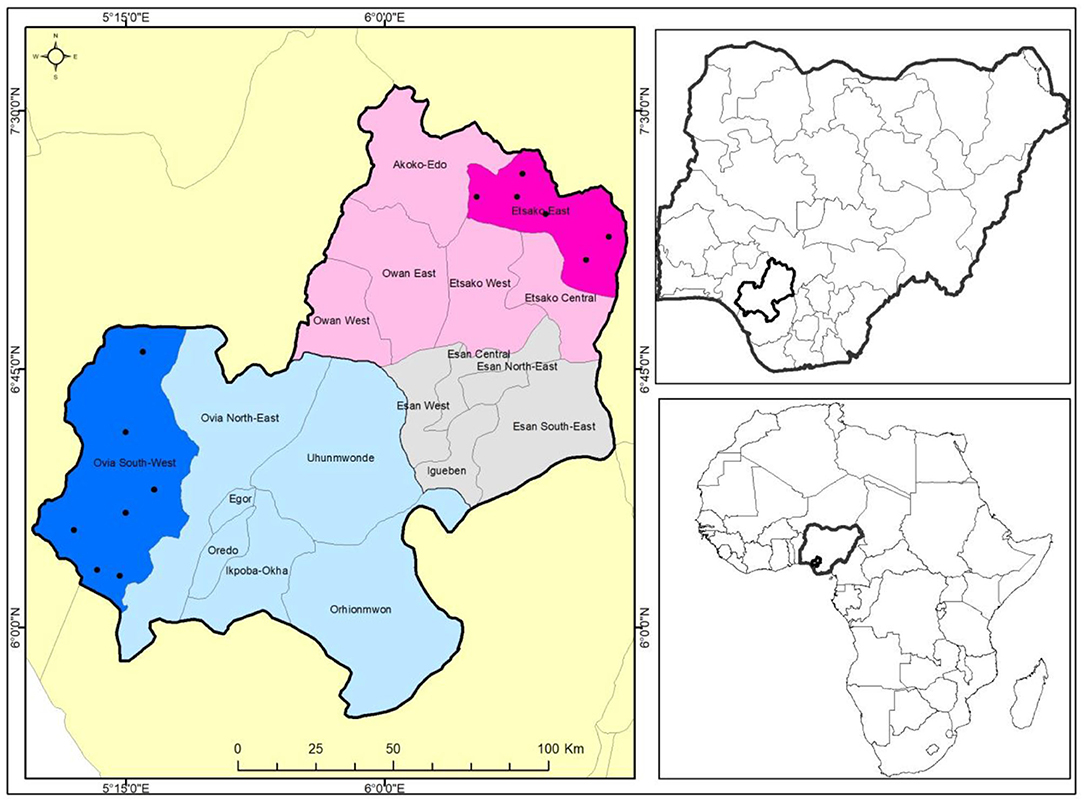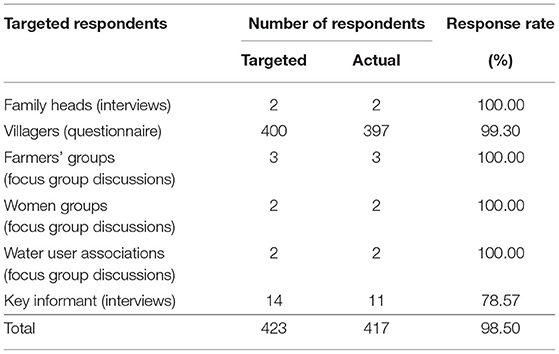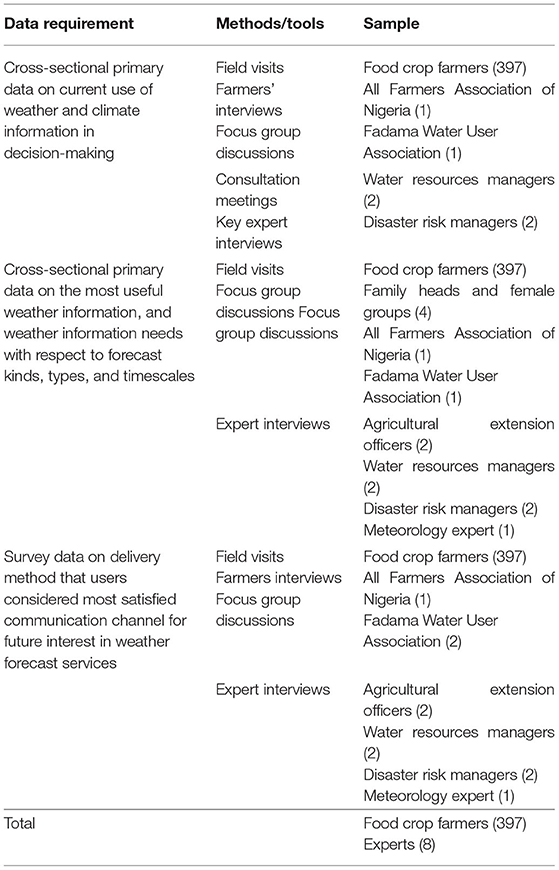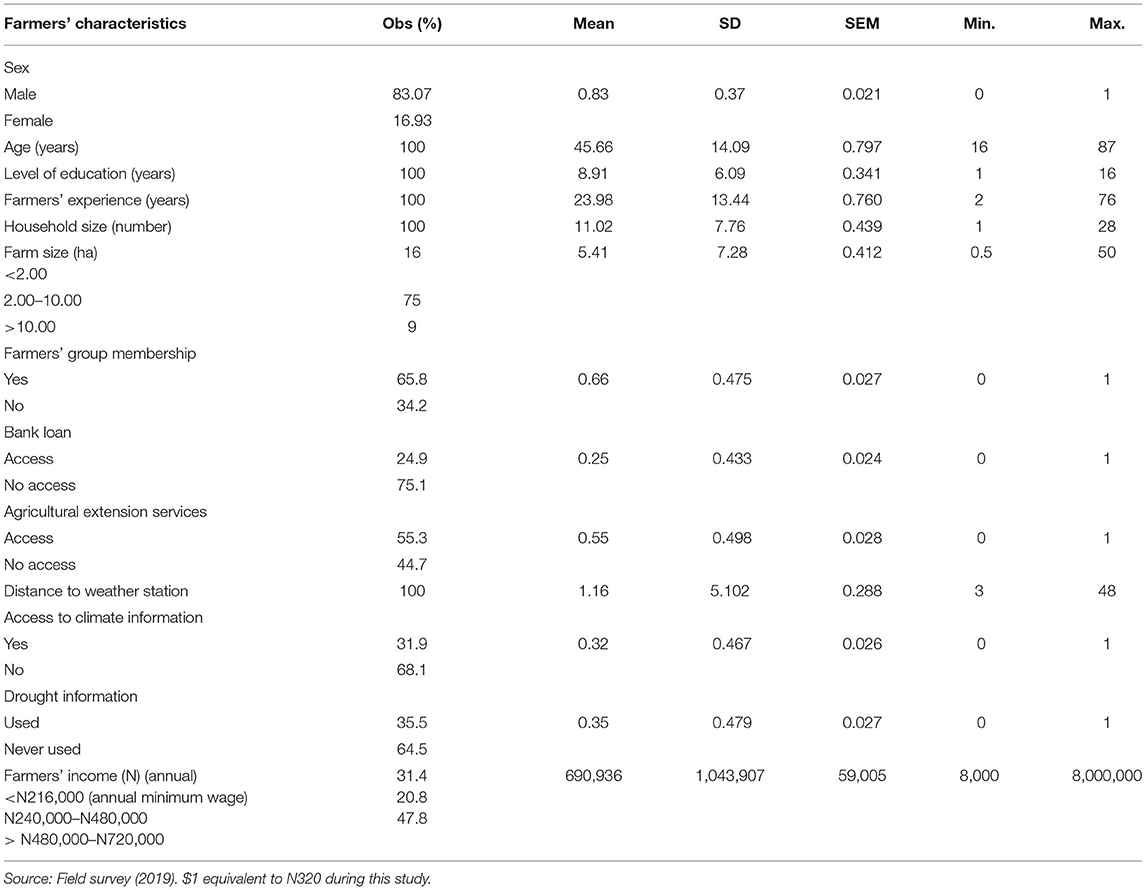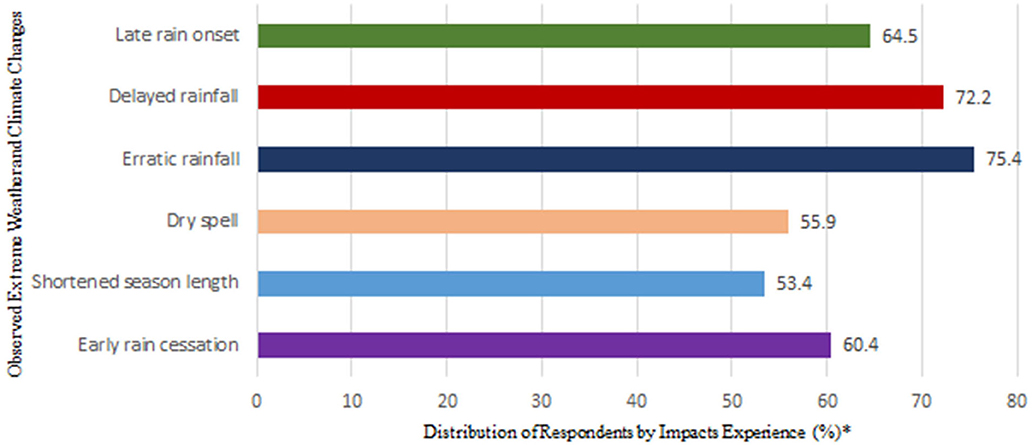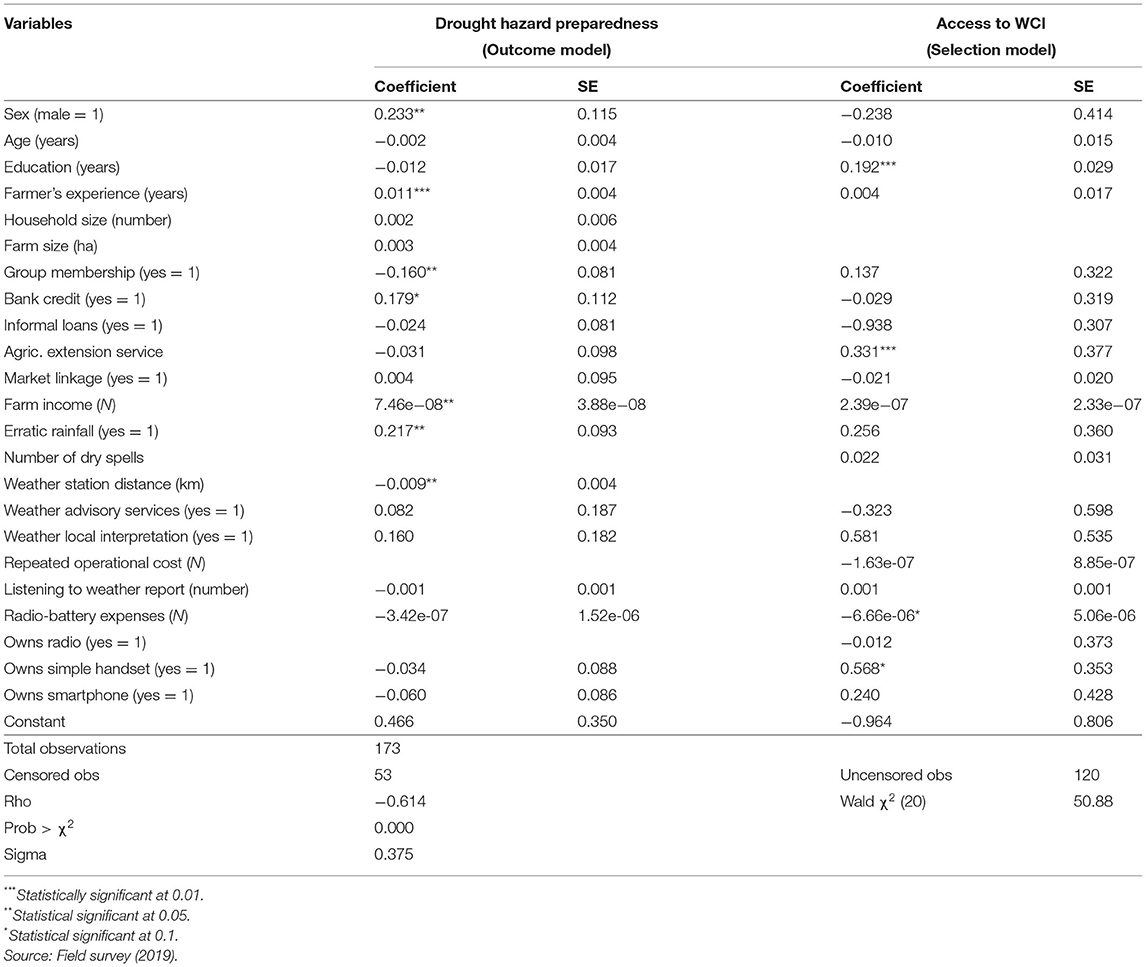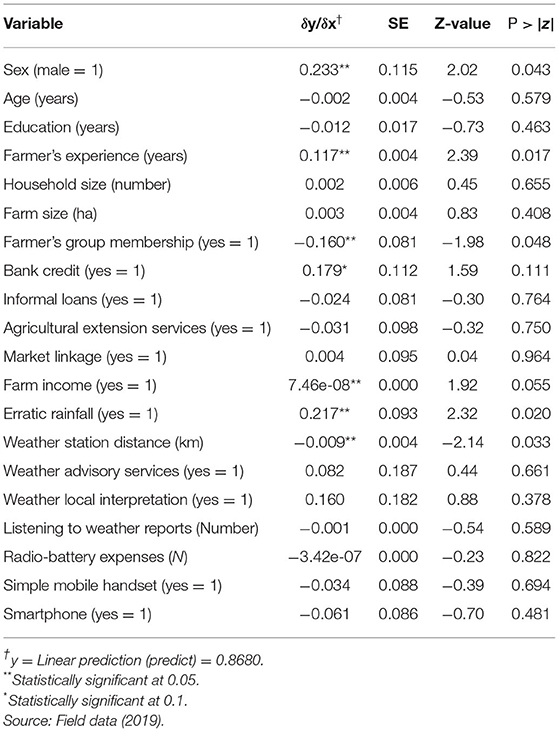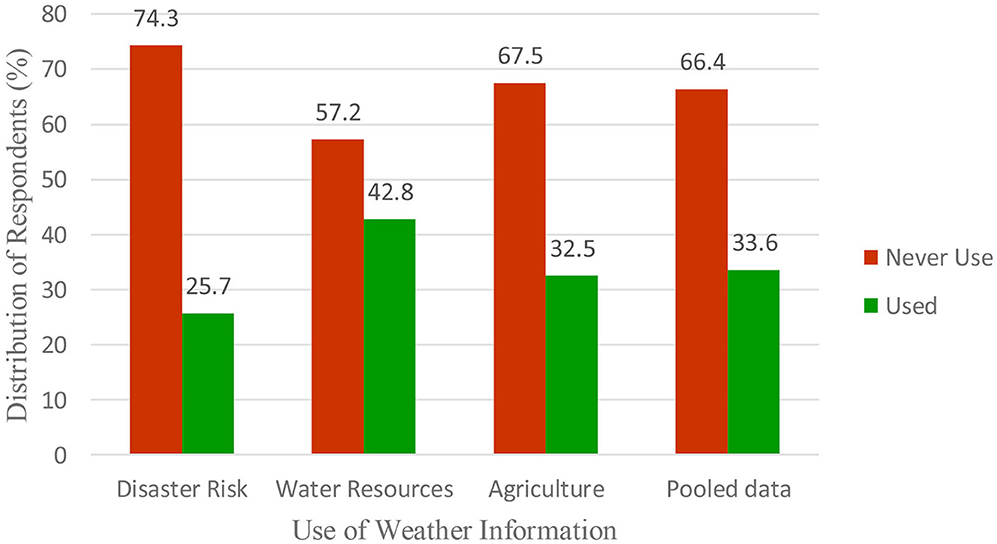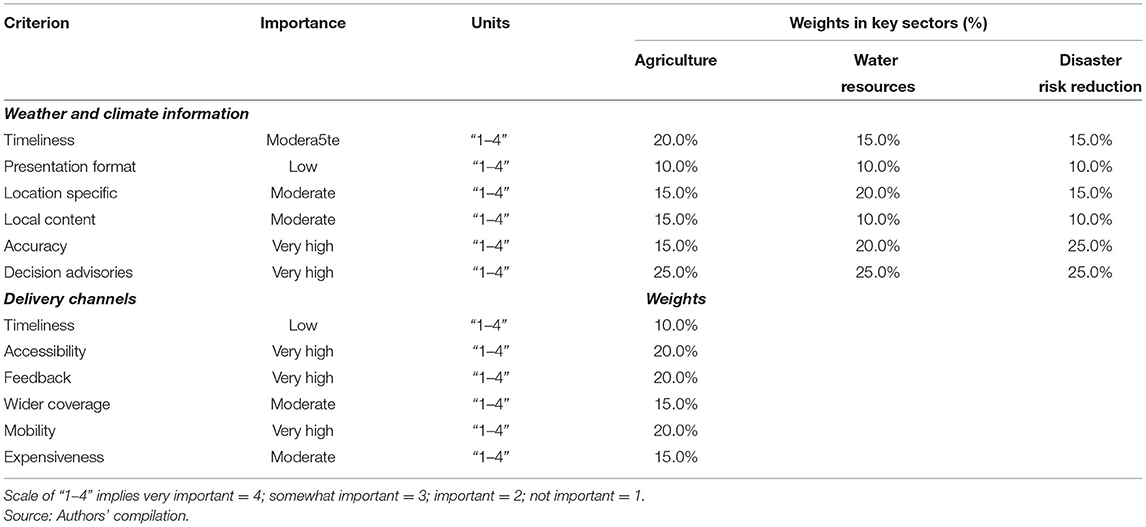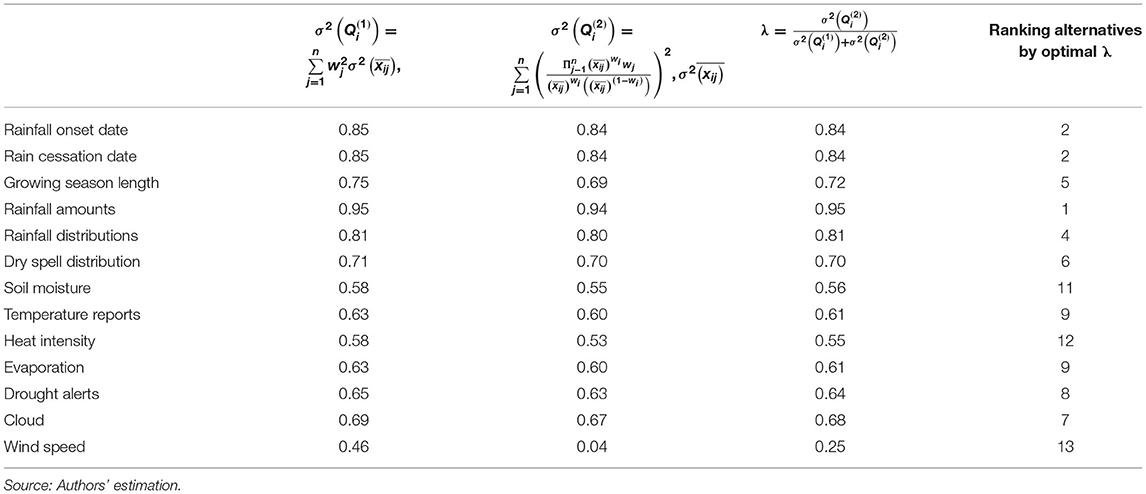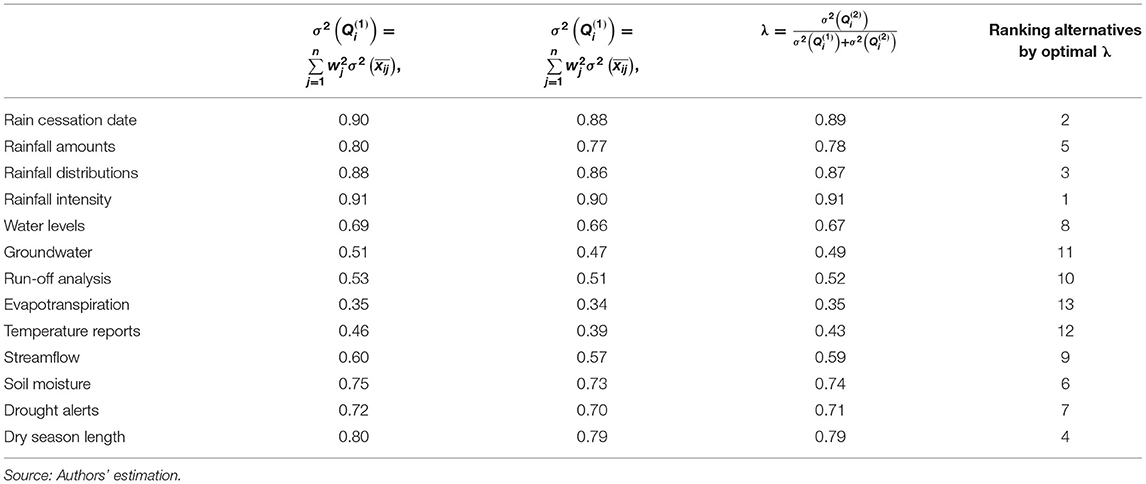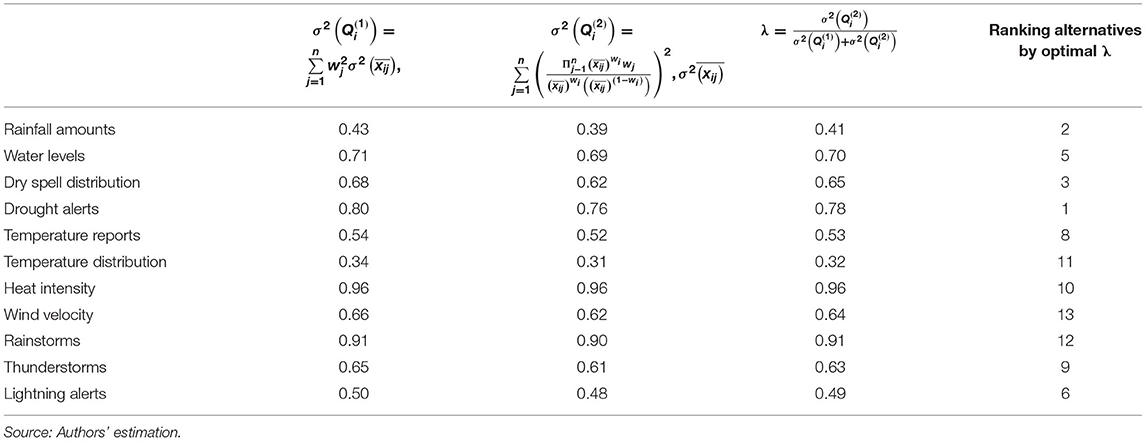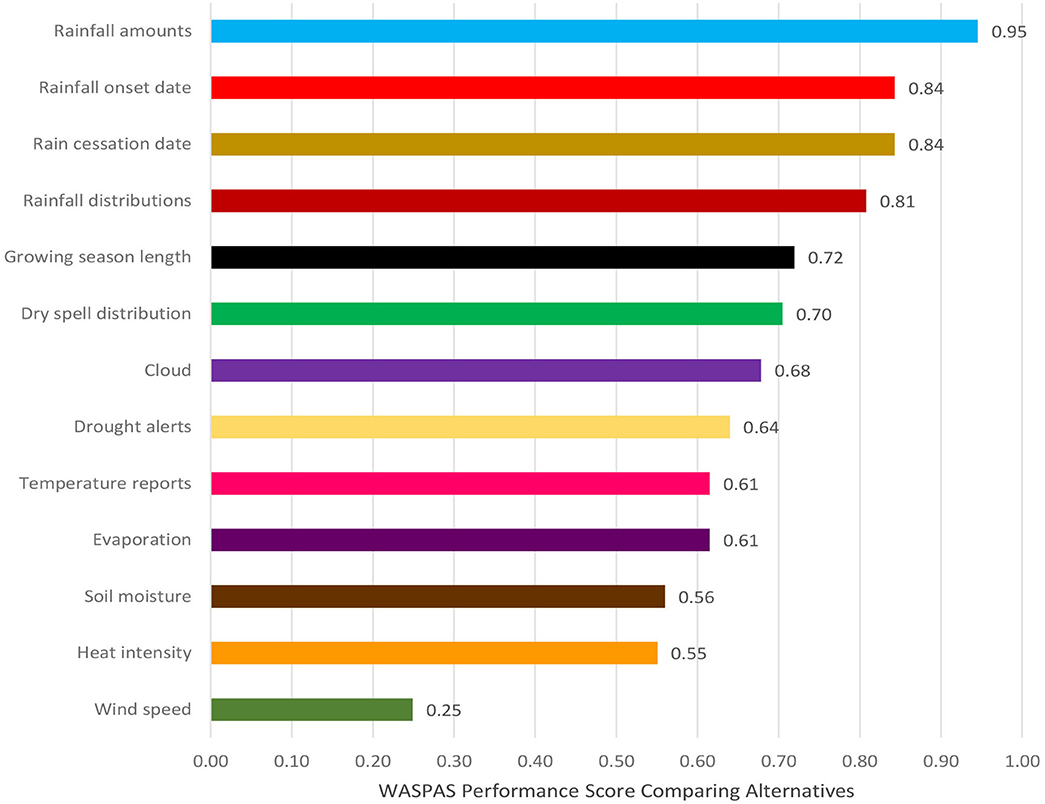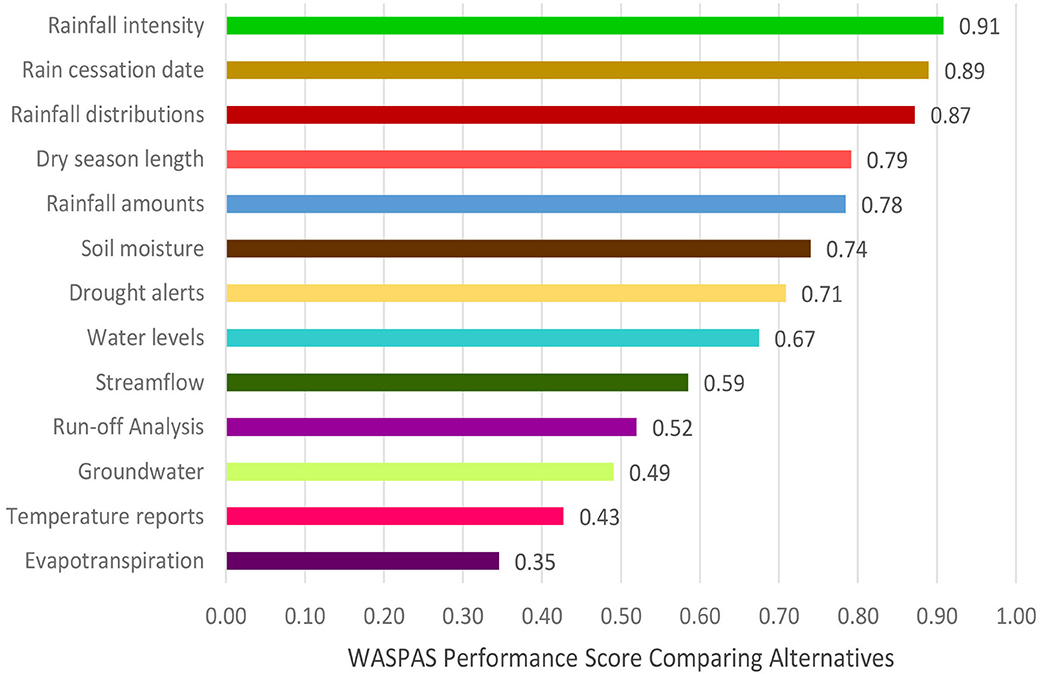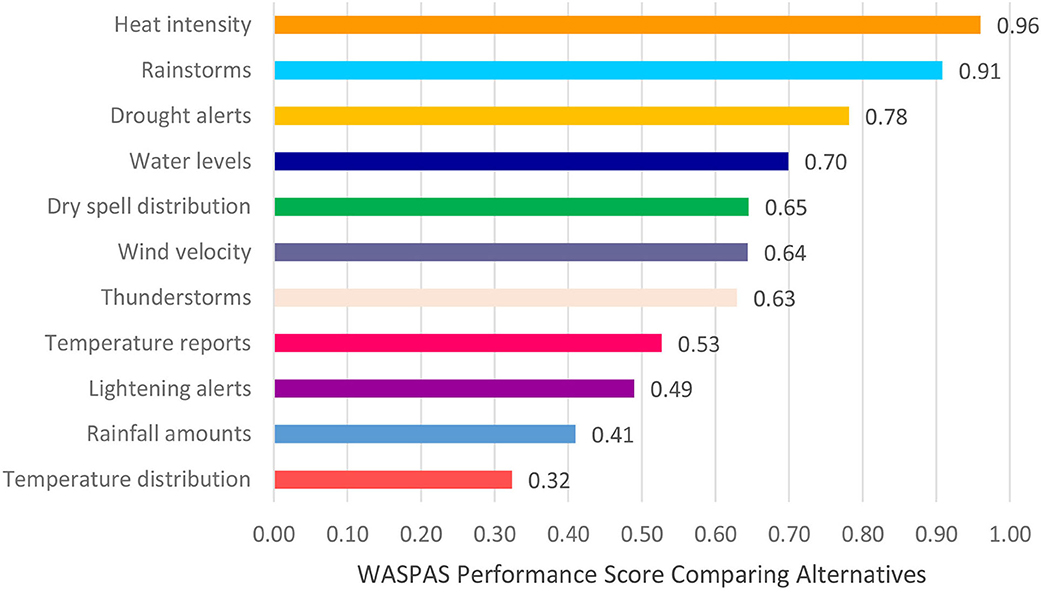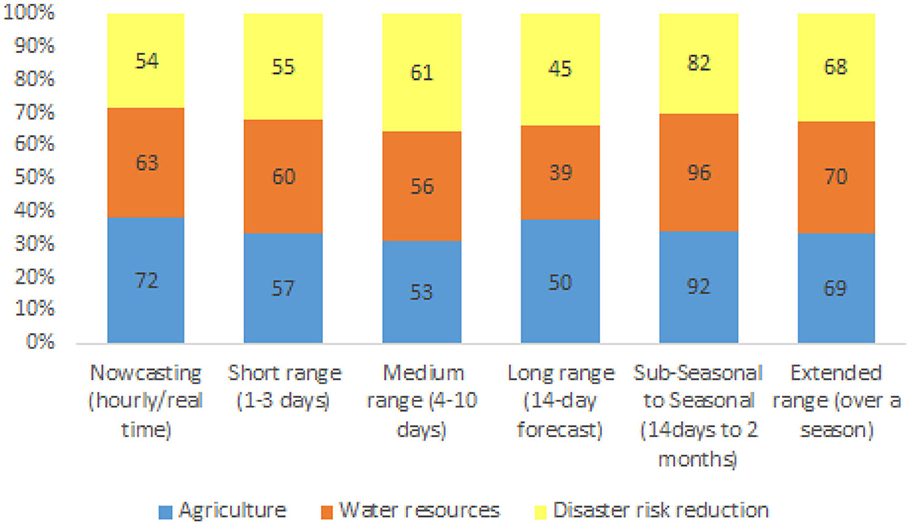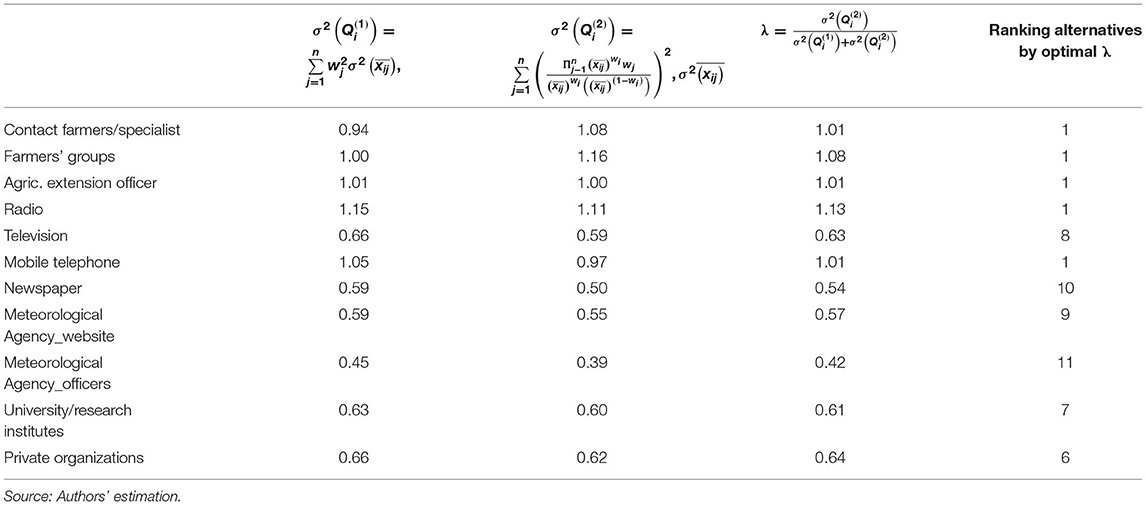Profiling User Needs for Weather and Climate Information in Fostering Drought Risk Preparedness in Central-Southern Nigeria
- 1Department of Meteorology, Faculty of Biological and Physical Sciences, University of Nairobi, Nairobi, Kenya
- 2Department of Agricultural and Resource Economics, Federal University of Technology Akure, Akure, Nigeria
- 3African Centre of Meteorological Applications for Development (ACMAD), Niamey, Niger
- 4Department of Meteorology and Climate Science, Federal University of Technology Akure, Akure, Nigeria
- 5Department of Environmental Science, College of Science, Kwame Nkrumah University of Science and Technology, Kumasi, Ghana
- 6Centre for Decision Research, Leeds University Business School & School of Earth and Environment, University of Leeds, Leeds, United Kingdom
Weather and climate information trigger early action and facilitate better disaster preparedness. Decision-driven and people-centered weather and climate information are pivotal for the effective uptake. The challenge of early responses in preparing for drought hazard is growing in the dry savannah of tropical sub-Saharan African countries. This paper analyzed user needs for weather and climate information in fostering drought risk preparedness in Central-Southern Nigeria. Stratified, snowball, and simple random samplings were used to obtain a sample of 397 respondents across the agro-ecological zones of Edo State. Structured questionnaire was used to collect farm-level household data across communities. Eight focus group discussions and 11 key informants' interviews were conducted, targeting contact farmers and other agricultural stakeholders in selected key economic sectors of Edo State, Central-Southern Nigeria. Results show that non-users of weather and climate information are more than users in the savannah area. Heckman probit results explained that male gender, farmers' experience, income, and persistent incidence of erratic rainfall have more propensity to facilitate use of WCI in taking critical decisions while group membership or associations and distance of meteorological station prevent stakeholders from developing interest in using WCI for drought preparedness and response. Multi-criteria decision-making indicated that rainfall amount, onset and cessation rainfall dates, and rainfall distributions are the most useful WCI needed by end users in their decision response plan in agriculture; rainfall intensity, rainfall cessation date, rainfall distributions, and length of dry season are ranked as the most useful WCI for water resource management while heat intensity, rainstorms, and drought alerts were ranked as most appropriate for users in the disaster risk reduction in fostering resilience toward anticipated future drought hazard. Subseasonal-to-seasonal (S2S) and medium (4–10 days) timescales information are the most highly rated to facilitate resource planning for efficient utilization and management in all the economic sectors. The users' most preferred delivery method of receiving WCI are mobile telephone, radio, agricultural extension officers, farmers' groups, and contact farmers/specialist for efficiency and convenient criteria in enhancing users' decision capacity to uptake WCI. There is a need for a policy drive to build synergy that will make WCI forecasting systems include impact-based forecast estimates and response advisory across a wide range of natural hazards. A seamless collaborative effort in bringing scientific outputs and users' needs together will increase the utility of WCI through systematic efforts. NiMet should improve on its engagement with the stakeholders, the agricultural extension and planning office, water management authorities, and disaster risk reduction and emergency response personnel as partner institutions. These policy actions would provide a robust collaborative framework for co-producing useable WCI based on user needs in managing decision points against extreme events and mainstream preparedness into existing decision-making apparatus of rural communities in Central-Southern Nigeria.
Introduction
Scientific evidence suggests that extreme weather events and climate variability, either under present or future climate conditions, will have severe consequences for development, and pose risks to food security and disaster risk management apparatus. Climate change is already modifying the frequency and intensity of many weather-related hazards as well as steadily increasing the vulnerability and eroding the resilience of exposed populations that depend on arable land, access to water, and stable mean temperatures and rainfall. Risk to weather-related hazards is concentrated in low- and middle-income countries (IPCC, 2014; UNDRR, 2020). Climate change is expected to exacerbate prolonged drought periods, shifts in rainfall patterns, flooding, and extreme heat conditions. Social, ecological, and economic vulnerabilities to such weather extremes currently exist, and will exacerbate existing vulnerabilities, creating new risks (IDB, 2015; TWB, 2015; FAO, 2016; Cho, 2019; World Bank, 2020; Awolala et al., 2021). These severe weather changes may increase both the frequency and intensity of disasters and the likelihood of mega disasters. The projected impacts of climate change that will drive disaster risk include decreasing agricultural yields in warmer environments due to heat stress with serious implications for rural livelihoods, long droughts aggravating poor availability of water resources for agricultural and domestic utilizations, and more severe and frequent extreme rainfall intensifying existing patterns of extensive risk in view of population growth (FAO, 2015; UNDRR, 2020).
The risk associated with weather-related hazards is disproportionately concentrated in developing countries and within these countries in poorer sectors of the population, thus rural livelihoods that depend on agriculture and other natural resources are vulnerable to even slight variations in weather and seasonality (Ziervogel et al., 2006; UNDRR, 2020). Agriculture is critical to the growth and development of Africa, responsible for over one-fifth of sub-Saharan Africa's economic output, hence extreme climate events could make it more challenging, especially in the arid and semi-arid regions (McKinsey Global Institute, 2020). The sector is increasingly showing a high level of vulnerability because its weather patterns are becoming less favorable, the frequency and/or severity of extreme events is increasing as projected rise in temperatures continue rising, and rainfall patterns are expected to shift more than they have already (Antwi-Agyei et al., 2012; Wood et al., 2014; Nwanze and Fan, 2016).
Africa is disproportionately affected by prolonged droughts given that most of its economies are climate dependent with poor infrastructural base. Drought is one of the critical extreme events facing the tropical savannah region of sub-Saharan Africa. In Africa, during the last decade (2010–2019), a significant increase of 52% in economic losses was recorded mainly due to floods, drought, and storms compared with the period 1970–2009 (Vicente-Serrano et al., 2012; CRED and UNISDR, 2020; WMO, 2020a). Drought has accounted for 95% of hydro-meteorological hazard-related deaths over the past 50 years. Between 1970 and 2019, disasters have accounted for US$ 38 billion in economic damages (WMO, 2020a). Over the last 50 years, 35% of deaths related to weather, climate, and water extremes have occurred in Africa. Vulnerable people in countries with weaker disaster preparedness systems are facing the greatest risks. Smallholder farmers in West Africa rely on rain-fed agriculture for their daily subsistence, making these farmers extremely vulnerable to the adverse impacts of climate fluctuations (Coulibaly et al., 2015). Consequently, food security and rural livelihoods, water availability, or per-capita renewable water resources are declining due to multi-prolonged destruction of rural irrigation systems, which pose an additional threat to freshwater resources for agricultural use and domestic purposes (FAO, 2018; Haider, 2019). In recent years, impacts of droughts are increasing in magnitude and complexity in Nigeria, particularly pronounced in increasing aridity and challenging traditional farming systems in the savannah areas (Abdullahi et al., 2016; Elijah et al., 2017; Hassan and Fullen, 2019).
Given that climate change is so closely linked to many underlying risk drivers, it must be addressed within the same context of reducing these drivers of risk. If these drivers are not addressed, disaster risk will continue to increase even if climate change is successfully mitigated (UNDRR, 2020). As extreme climate events continue to threaten human lives, ecosystems, and economies, climate information and early warning system is increasingly observed as a key strategy for reducing impacts of these hazards. The key strategy to minimize current disaster risks implies improving the disaster preparedness efforts and integrating disaster risk reduction into development strategies. Disaster preparedness contains the activities and measures taken in advance to ensure an effective response to the impact of hazards, including timely and effective early warning systems (ISDR, 2001; Lavell et al., 2012; WMO, 2020b).
The National Center for Disaster Preparedness (2016) observed a growing recognition linking climate change and disaster preparedness is on the premise that the understanding will assist to prioritize efforts in preventing, preparing, and responding through planning prevention interventions (IFRC, 2003; Petkova, 2021). Disaster preparedness measures, including early warning, serves as a bridge between disaster risk reduction and disaster management. Preparedness attempts to assist vulnerable communities in eliminating adverse effects that could be experienced once a physical event(s) occurs (Cutter et al., 2012). Early Warning System (EWS) is a top adaptation priority in the Nationally Determined Contributions (NDCs) of the majority of Parties to the United Nations Framework Convention on Climate Change (UNFCCC), including Nigeria. EWS is a key proven measure for effective disaster risk reduction and adaptation (UNFCCC, 2017). Access to useful and quality-controlled climate information is inevitable for better informed decisions aimed at addressing existing and future weather and climate-related hazards (Nkiaka, 2019; Antwi-Agyei et al., 2021). Weather and Climate Services (WCS) can provide decision support information in facilitating both climate change adaptation efforts and disaster risk reduction practices (Street et al., 2019).
Given this perspective, the focus on agriculture, water resources, and disaster management sectors is justified by their climate sensitivities (Vaughan et al., 2016; FAO, IFAD, UNICEF, WFP, and WHO, 2018), and the overall significance as priority areas within the Global Framework for Climate Services (GFCS) that provide a worldwide mechanism for coordinated actions toward enhancing the quality, quantity, and use of WCS. Effective climate services will facilitate climate-smart decisions that will address the impacts of climate-related disasters, improve food security, enhance water resources management, and improve outcomes in disaster risk reduction (World Meteorological Organization, WMO, 2013; Nkiaka, 2019).
Context Of Climate Information In Managing Extreme Events
WMO (2020b) defines Weather and Climate Services (WCS) as the transformation of climate-related data and other information into customized products such as projections, trends, economic analysis, advice on best practices, and any other useful services. This stressed the importance of a user-driven approach rather than the supply-driven Global Framework for Climate Services (GFCS) definition merely as to strengthen the production, availability, delivery, and application of science-based climate prediction and service. WCS provide science-based and user-specific information relating to past, present, and potential future climates helping countries make better and informed decisions in climate-sensitive sectors, thereby generating substantial economic benefits and sustainable development (Snow et al., 2010). The Global Framework for Climate Services (GFCS) defines climate services as climate information prepared and delivered to meet users' needs (WMO, 2011).
Climate services have been identified as adaptation measure that could assist on local scale by enhancing disaster preparedness actions against droughts and dry spells, especially in the savannah drylands (Jones et al., 2014). Climate services are regarded as generation, provision, and contextualization of information and knowledge obtained from climate research for decision-making in all climate-sensitive sectors. It helps develop and disseminate climate relevant information for decision-making (Mjelde et al., 2000; Vaughan and Dessai, 2014; Brasseur and Gallardo, 2016). In Africa, addressing impacts of extreme events through access to weather information, early warnings, and other adaptive mechanisms are foremost in climate policy dialogues and development agendas of many countries (Oyekale, 2015b; Awolala, 2018; Vogel et al., 2019). The overarching goal of the GFCS Adaptation and Disaster Risk Reduction in Africa program is to provide timely and accurate climate and weather services for disaster risk reduction and increased resilience in agriculture (WMO, 2021a). Climate information has played a significant role in improving the management of water resources and making the agriculture sector in the arid areas more resilient. The establishment of a warning system to cope with climate uncertainties helps to provide advice to farmers on sustainable agricultural practices (Britz, 2021). Nevertheless, despite improved capacities in disaster risk knowledge and forecasting that are relatively well advanced in Africa, there is a need to make this information actionable and accessible so as to better link information to action (UNDRR, 2020; WMO, 2020b). There has never been a more critical time to work on improving adaptation to climate-sensitive disasters by applying scientific approach on how people prepare and respond to future disasters (Petkova, 2021).
Nigeria is classified as one of the 10 most vulnerable countries to the impacts of climate change and natural hazards (Climate Scorecard, 2019) and ranked 160 out of 181 countries in the 2020 ND-GAIN Index, which emphasized serious attention to set the goal of readiness to improve resilience by prioritizing decisions for more efficient responses (University of Notre Dame, 2020). An estimated 24% of Nigeria's population (about 41 million people) are living in high climate exposure areas (GFDRR, 2019). The high vulnerability to seasonal variations and long-term climate changes has cumulative impacts (Olagunju, 2015; Ayanlade et al., 2018). The trends in extreme events especially are threatening its overall economic structures, notably the regular multiple hazards such as increased aridity and drought, increased duration of dry spells, and rising temperatures, among others (World Bank, 2021). The high levels of poverty, low degree of development, and dependence on rain-fed agriculture limit the capacity of rural households and constrain communities to manage climate risk, increasing their vulnerability to climate-related shocks (UNFCCC, 2016). Significant consequences are expected for the country's water resources (UNFCCC, 2020), agriculture (UNFCCC, 2018, 2021), and disaster risk prone areas (USAID, 2019). Nigeria is working to advance its disaster risk management (DRM) agenda through resilience efforts to share data from climate information and early warnings, develop plans for disaster preparedness, and planning the agricultural and allied sectors at community levels (GFDRR, 2019).
Climate services are primarily available through the Nigerian meteorological and hydrological agencies, aimed at generating climate-smart decisions across all socio-economic sectors (NiMet, 2021; The Cable, 2021). The agency helps the grassroots understand its application in the agricultural value chain (WMO, 2021b) and transform climate information systems into relevant warnings useful for end users. Despite recent improvements in the operational weather and climate forecasting with the development of Numerical Weather Prediction (NWP) models and partnerships with the WMO for operational activities (NiMet, 2021), there are serious challenges limiting uptake of WCI. Underutilization of available WCI at the grassroots for climate risk management and preparedness decisions is limited because of low education and inadequate financial support that result in limited ability to adopt innovative communication technologies to access WCI (Baumüller, 2016; Tall et al., 2018; Krell et al., 2021), lack of relevance and misalignment between the climate information provided and actual information needs of users (Dilling and Lemos, 2011; Ekstrom et al., 2011; Li et al., 2012; Awolala, 2018; Nkiaka, 2019; Muita et al., 2021), and disconnection between service providers and user institutions (Antwi-Agyei et al., 2020; Hansen et al., 2019; Naab et al., 2019; Sultan et al., 2020). Furthermore, the inability to provide precise site-specific WCI due to sparse and poor weather observation network (Guthiga and Newsham, 2011; Kusangaya et al., 2014; Karuma et al., 2016), uncertainty in various types of climate information constraining decision-making, unsuitability to inform decision-making required by communities (Silvestri et al., 2012; Apgar et al., 2017), ineffective dissemination of climate services reaching the most vulnerable and poor understanding by vulnerable communities (Onwuemele, 2014; Vaughan and Dessai, 2014; Jones et al., 2015; Adenle et al., 2017; Awolala, 2018; Nkiaka, 2019; Antwi-Agyei et al., 2021), and poor capacity of agencies providing hydrological information and warning services to provide climate services for water, and emergency preparedness (Ziervogel et al., 2008; Kumi et al., 2020; Britz, 2021), have been recognized as barriers that have made WCI credibility doubtful and limiting the uptake on climate information in making smart decisions on risk preparedness by communities.
In recent times, sharing of information on weather and climate has improved by the Nigerian Meteorological Agency (NiMet) and the Nigerian Hydrological Services Agency (NIHSA). There have been more use of online and news media as medium of dissemination. Some partnering public institutions have also increased their efforts in climate communication by incorporating advisory services, although the size of the coverage is still low due to the very large population. Past studies on impacts of climate change in Nigeria have mainly addressed response patterns with resultant implications for environment and livelihoods (Adeaga, 2011; Garba et al., 2013a,b; Ifaniyi, 2013; Haider, 2019; Ogunrinde et al., 2019; Ohiomu and Ozor, 2021; World Bank, 2021); nevertheless, the extent at which households' decision-making capacity are enhanced for taking actions in drought risk preparedness with WCI has never been articulated in these studies. Rural communities do not often use WCI on a regular basis, hence the specific influence of weather parameters on local scale decision-making is not well known, thus there is an urgent need to better integrate weather and climate information into societal decision-making processes. Ensuring the relevance and appropriateness of tailored information in facilitating risk management decisions remains the persistent challenge for the service provider community. The extent to which the WCI are shared primarily for the purpose of local decision-making remains unclear.
The overall goal of this study is to provide a deeper understanding of the specific climate information needs of end users as they plan their resilience and adaptive capacity to drought hazard. The key questions remain: What are the gaps in the packaging, dissemination, access, and utilization of WCI? What are the appropriate WCI that could best equip communities to develop drought hazard preparedness plan? What drives individual decisions to use WCI in drought hazard preparedness as a climate-smart strategy? This study attempts to answer these questions by assessing the climate information needs in the agriculture, water resources, and disaster management sectors. The study will guide the development of synergies between forecasters and end users as stakeholders in co-producing and communicating decision-driven climate information for response effectiveness and preparedness planning by rural households in managing the risks associated with extreme climate events.
Farm-Level Decision-Making: Conceptual And Theoretical Framework
The study analyzed determinants of decisions for using weather and climate information as a drought hazard preparedness strategy. The framework begins by emphasizing that farmers can be irrational thereby unable to optimize returns from their decision-making processes (Clark and Marshall, 2002; Ziervogel, 2004). Ziervogel (2004) described this premise upon which such decisions are based as “bounded rationality” due to non-existence of perfect knowledge. It is based on the theory of technology adoption theory, which posits that social, economic, ecological, and institutional systems as well as individuals can drive adaptation to changing environment. The level of sustainable adaptation depends on the adaptive capacity, information, knowledge, social networks, assets, infrastructure, and institutions accessible to enable undertaking effective adaptation (IPCC, 2007).
Technology innovation utilization has been guided mainly by innovation-diffusion, economic constraint, and adopter perception paradigms. Innovation-diffusion paradigm identifies information dissemination as a key factor in influencing adoption decisions while the economic constraint paradigm argues that technology adoption is influenced by utility maximization behavior and economic constraints due to asymmetric distribution of resources. On the other hand, the adopter perceptions paradigm posits that the adoption process starts with the adopters' perception of the problem and technology proposed. The adopter perception paradigm argues that perceptions of adopters are important in influencing adoption decisions (Kalinda, 2011).
The decision to participate in implementing an intervention is based on perceived utility expected by a farmer but is also influenced by individual and socio-economic characteristics, as well as market, institutional, and environmental factors influencing the decision-making processes. Farmers' overall objective is to improve the household welfare, thus to participate in an intervention, a farmer has an expected utility of the intervention associated with the influencing factors. Agricultural objectives in addition to public infrastructure contribute as basic conditions that influence a farmer to participate or not in the intervention. The basic conditions, expected utility, and the factors influencing the participation decision will all lead to impact, improved welfare.
This study used the random utility theory approach, which posits that a farmer's decision to participate in a drought hazard preparedness strategy depends on the level of utility expected to derive from that participation (Up). Therefore, a farmer will only participate in a strategy i if the expected utility of participation (Uip) is greater than the utility without participation (Uin) (Ali and Abdulai, 2010). Therefore, the decision to participate in the strategy is a discrete choice in which a farmer can decide to use the strategy or not based on idiosyncratic preferences, farm characteristics, and institutional and environmental factors, among others. The level of integrating WCI into the overall household decision-making framework, hence use of WCI, depends on each farmer's self-selection behavior rather than on a random assignment to the strategy. Denoting the difference between the net utility of usage and non-usage for each farmer i gives
Equation (1) means that farmer i will use the strategy if the perceived utility of usage exceeds that of non-usage, ceteris paribus.
The Analytical Framework
Heckman probit selection model was used to analyze factors influencing use of weather and climate information (WCI) for drought hazard preparedness decisions as a climate-smart strategy. In many studies where the decision to uptake a new technology involves a decision process requiring more than one stage, models with two-step regressions are commonly used to correct for the sample selection bias generated in such decision-making processes. William and Stan (2003) used Heckman's two-step procedure to analyze factors affecting the awareness and adoption of new agricultural technologies in the USA. The first stage was the analysis of factors affecting awareness of new agricultural technologies, and the second stage is the adoption of the new agricultural technologies. Yirga (2007) and Kaliba et al. (2000) used Heckman's selection model to analyze the two-step processes of agricultural technology adoption and intensity of agricultural input use in Ethiopia. Maddison (2006) analyzed farmers' adaptation to climate change in South Africa and found farmers' adaptation is a two-step process which first involves perceiving a changing climate and then second, responding to changes through adaptation. Deressa et al. (2008) used Heckman's two-step procedure to analyze farmers' perceptions of climate change, and next, farmers' adaptations to climate change. Gbetibouo (2009) used Heckman's model to analyze farmers' perceptions and adaptations to climate change and variability in the Limpopo basin, South Africa. In the first stage, farmers' perceptions were analyzed followed by farmers' adaptations in the second stage.
Following Maddison (2006), this study applied Heckman's probit selection model to analyze the access and use of WCI by farmers in study area. Heckman' model has two equations of interest, the selection (access) equation and the outcome (use) equation. The selection equation was used to model farmers' access to WCI services for hazard preparedness while the response equation was used to model application of WCI as a strategy in preventing losses to drought shocks. In their studies, Maddison (2006), Deressa et al. (2008), and Gbetibouo (2009) specified Heckman's sample selectivity model based on two latent variables as follows:
where ϕ is a k-vector of regressors; β is an m-vector of regressors, possibly including 1's for the intercepts; and the error terms μi and εi are jointly normally distributed, independently of ϕ andβ, with zero expectations. y1andy2are the regressands denoting use and access of weather and climate information. While this study is primarily interested in the first model, the latent variable is only observed ify2 > 0. Then, the actual dependent variable is
y2 is taken as a latent variable, which is not observable, but only its sign. It is concluded that y2 > 0 if y is observable and that y2 ≤ 0 if y is unobservable. Therefore, without any loss of generality,εican be normalized so that it has a variance of 1. Suppose the self-selection problem is disregarded and y regressed on ϕ based on the observed y values, then the resulting ordinary least squares (OLS) estimator of would be biased, since
where F is the cumulative distribution function of the standard normal distribution, f is the corresponding density, s2 is the variance of μi, and r is the correlation between μiandεi. Therefore:
The final term gives rise to self-selection bias when r is non-zero. To avoid the self-selection bias and obtain asymptotically efficient estimators, the maximum likelihood estimation (MLE) was used to estimate the model parameters.
Methodology And Data
Description of the Study Area
The study was carried out in Edo State, Central-Southern Nigeria. The inland state lies in the tropical rainforest zone of Nigeria with a total land surface area of 19,281.93 km2 with population of over 5 million persons (Emeribe et al., 2017). It possesses a humid tropical climate based on Köppen climatic classification, typical of the tropical rainforest zone vegetation. The average annual rainfall in the north of the State ranges between 127 and 152 cm but in the range of 252 and 254 cm in the south (Koyenikan and Anozie, 2017). The basis of the economy is livelihood activities in smallholding farming, fishing, aquaculture, poultry, and livestock in many communities. The state derives an estimated 40% of its revenue from proceeds from agriculture. The rural population of about 200,000 largely depends on subsistent agriculture, which is responsible for about 80% of the total agricultural production in Edo State (www.edostate.gov.ng/commercialagriculture). The urban economy is dominated by government in the formal sector and trade in the informal. Government is the main employer for the wage-earning part of the population because about 50% of the urban work force is in clerical and sales-and-service professions. Other livelihoods involve services and trading by both men and women. Edo State consists of eighteen (18) Local Government three agro-ecological zones with the guinea savannah, derived savannah, and mangrove forest describing the agricultural regions of Edo North, Edo Central, and Edo South, respectively. Edo North agro-ecological zone has a sub-humid climate, characterized by light rainfall and semi-savannah vegetation. Edo Central zone is characterized by derived savannah vegetation while the climate is humid tropical in the Edo South (Oladipupo et al., 2014). Figure 1 shows the map of Edo State in Central-Southern Nigeria showing the study sites. Edo State is experiencing a fast-disappearing vegetation and increasing aridity, which characterized the savannah area in recent times.
Sampling Techniques, Sample Size, and Data
This study focused on households from rural communities drawn from three agricultural zones of Edo State. Edo North has an estimated population of 1,252,100, Edo Central has 775,000 people, and the projection is 2,208,700 in Edo South (Brinkhoff, 2016). The State was purposively selected because of its fast-disappearing vegetation due to its increasing aridity, characterized by the dry savannah with negative consequences for the teeming rural population. The agricultural zones were stratified by Agro-Ecological Zones, Blocks, and Cells. Household data for the study were collected through field survey conducted during the 2019 farming season using a multi-stage sampling technique. The study area was stratified into three agro-ecological zones, namely Edo North, Edo Central, and Edo South zones, to allow for characteristics that may affect responses across different zones shaped by biophysical, socio-economic, and environmental context of the areas (Lema and Majule, 2009), and based on the Edo State Agricultural Development Programme delineation.
Edo North is made up of six Local Government Areas (LGAs), Edo Central has five LGAs and Edo South zone has seven, making a total of eighteen LGAs, which formed the Blocks. At the Zonal Level, the sampling process involved purposive selection of the three Edo North, Edo Central, and Edo South agroecological zones. At the Block level, one block each was randomly selected from a total of 6, 5, and 7 blocks in the North, Central, and South Zones, respectively. These blocks were Etsako East in Edo North, Esan South East in Edo Central, and Ovia Southwest in the Edo South Zone. At the Cell level, each block consists of 8 cells. A random selection of 6 cells were made from blocks one and three but 4 cells from block two, for a total of 16 cells that made up the rural communities. At the Farmers' level, both snowballing and simple random sampling techniques were then used in selecting 25 farmers from each community. Of the 400 respondents interviewed, the data from 3 copies of respondents' interview schedule were invalid due to some exaggerations; therefore, a total of 397 respondents were used for analysis. The distribution of final samples across the study sites are presented in Table 1.
Reconnaissance visits to the study area were facilitated by the extension workers from the Edo State Agricultural Development Programme (EDADP). The outcome of this reconnaissance also informed the selection of key stakeholders who were engaged in the inception meeting that was later held with the local farmers, community members, community heads, EDADP contact farmers, and the key informants. The outcome from the deliberations was used to develop the structured questionnaire used for the survey. The researcher personally administered the structured questionnaire prepared in English Language and interviewed respondents with six trained field assistants from the agricultural extension personnel of EDADP and Department of Agricultural Economics, University of Benin, Edo State. The Pre-testing of the questionnaire was conducted and checked through an iterative process for 5 days prior to the actual survey. The researcher acquired approval from the village heads before embarking on the study after providing explanations on the study objectives to the community leaders.
Given the permission, the first phase in the data collection, the researcher proceeded onto the participants for the survey enumeration. In each community, the household head was interviewed, or anyone with authority to speak. The questionnaire was administered in local languages with the assistance of field assistants who translated the questionnaire into Edo, Igarra, Etsako/Afemai, and Esan dialects for proper decoding during enumeration. The structured questionnaire elicited information on socio-economic profile of the respondents, and questions on what existing gaps in the packaging, dissemination, access, and extent of utilization of WCI in taking preparedness decisions? What appropriate WCI that could best equip communities to develop drought hazard preparedness plan? What drive individual decisions to use WCI in drought hazard preparedness as a climate-smart strategy? What types of information time scale required for end users to make adjustment plans indicating that they value information available to them? The questionnaire was developed to assess climate information needs in the target economic sectors of agriculture, water resources, and disaster management, rather than scientific forecast products and services produced by the meteorological agency. In the second phase, individuals who were recognized during the survey with sufficient agro-ecological and environmental knowledge were selected for focus group discussions (FGDs). In all, 8 FGDs (2 family heads, 2 women groups, 3 farmers' groups, and 1 water user association) were held in the study communities with participants ranging from 10 to 12 persons. Focus groups were conducted to validate responses obtained during survey enumeration based on life's experiences from the respondents.
The researcher also made appointments with key informants selected based on their understanding of local environmental changes, agricultural systems, and households' vulnerability to extreme climate events within the 16 communities. In the agricultural sector, key informant interviews (KIIs) were planned with officers of the Edo State Agricultural Development Project (EDADP), Federal Ministry of Agriculture and Natural Resources (FMANR), and All Farmers Association of Nigeria (AFAN). In the water sector, KIIs were planned with Edo Fadama Water User Association (EFWUA) and Benin-Owena River Basin Development Authority (BORBDA) officers; in the disaster management, the National Emergency Management Agency (NEMA) and Edo State Emergency Management Agency (ESEMA) officers. The climate service provider, the Nigerian Meteorological Agency (NiMet), officers were also interviewed. These key informants have been offering climate-related technical assistances to the local communities. At a designated time, the researcher conducted face-to-face interviews with the key informants. In the third phase, 14 key informants were targeted but 11 KIIs conducted comprise 2 officers from EDADP, 1 from FMANR, 2 from AFAN, 2 from EFWUA, 1 officer from BORBDA, 1 from NEMA, 1 from ESEMA, which are rendering disaster risk reduction program, and 1 from the NiMet.
These interviews were conducted to validate responses on the use of climate information in decision-making, most useful WCI and time scale that are decision driven to end users, and the most required delivery methods or effective communication pathways across agriculture, water, and disaster risk management sectors in the study communities. These sectors have been identified by stakeholders as sectors with great potential for optimal impact from the improved decision-driven climate information and services, if well utilized. These key informants were selected based on their proximity and in-depth knowledge on the research problems in the communities. These interviews were conducted to investigate the status and extent to which climate information is capable of informing preparedness plans of local communities. They explained some periodic government's activities through their offices on the uptake of climate information services in facilitating preparedness plan to extreme hazards. The distribution of the respondents is presented in Table 2.
Table 3 presents the summary of data requirement, collection methods, and sample used in analyzing research problems for the study.
Data Analysis
Descriptive Statistics
Descriptive statistics such as frequency distributions, means, percentages, standard deviations, and minimum and maximum values were used to describe socio-economic and demographic characteristics of the respondents, analyze the distribution of users and non-users of WCI in operational decision-making, existing gaps in the packaging, dissemination, access, and the extent at which farmers utilize WCI in taking preparedness decisions, actual climate information needs which are sufficiently useful in taking drought hazard preparedness decisions in the agriculture, water resources and disaster risk management sectors, and types of information time scale required for end users to make adjustment plans in the study area.
Multi-Criteria Analysis
Multi-criteria analysis was performed to determine the appropriate WCI that could best equip communities to develop drought hazard preparedness plan and response action. Decision-making problems often involve a complex decision-making process by which multiple requirements and uncertain conditions have to be taken into consideration simultaneously (Haque, 2016). Effectiveness of multi-criteria decision-aiding system as well as accuracy of decisions is based on an application of a proper multi-criteria decision-making method (MCDM) method (Zavadskas and Turskis, 2011; Alinezhad and Khalili, 2019).
The Weighted Aggregated Sum Product Assessment
Weighted aggregated sum product assessment (WASPAS) method was applied in this study, which involved an increase in the ranking accuracy of various WCI that users can use to take drought preparedness and response action. The analysis was performed for the users in the agriculture, water resources, and disaster risk reduction sectors. The optimization of weighted aggregated function methodology was applied in this study, which enables to reach the highest accuracy of estimation (Zavadskas et al., 2012).
The weighted sum model (WSM) is one of the best known and often applied multi-criteria decision-making methods in recent times for evaluating a number of alternatives in terms of a number of decision criteria. A given MCDM problem is defined on m alternatives and n decision criteria (Alinezhad and Khalili, 2019). wjdenotes the relative significance of the criterion and xij is the performance value of alternative i when it is evaluated in terms of criterion j. Then the total relative importance of alternative i, denoted as , (– normalized value of j-th criterion of i-th alternative) (Bagočius et al., 2013; Alinezhad and Khalili, 2019):
where linear normalization of initial criteria values is applied, that is:
if maxixijvalue is preferable or
If minixij value is preferable.
According to the weighted product model (WPM), the total relative importance of alternative i, denoted as, is expressed as stated (Bridgman, 1922; Miller and Starr, 1969; Triantaphyllou and Mann, 1989):
There was an attempt to apply a joint criterion for determining a total importance of alternative, giving equal contribution of WSM and WPM for total evaluation (Saparauskas et al., 2011):
Based on previous research (Saparauskas et al., 2011; Zavadskas et al., 2012) and supposing the increase of ranking accuracy and, respectively, the effectiveness of decision-making, the Weighted Aggregated Sum Product Assessment (WASPAS) method for ranking of alternatives is proposed in the current study. Following Eqs. (7), (10), and (12), the expression can be written as follows:
Accuracy of Estimation Based on Initial Criteria Values
It is proposed to measure the accuracy of WASPAS based on initial criteria accuracy and when λ = 0, …, 1. When λ = 0, WASPAS is transformed to WPM; and when λ = 1, WASPAS is transformed to WSM. Assuming that errors of determining the initial criteria values are stochastic, the variance σ2 or standard deviation σ is a measure of dispersion in the distribution.
Optimization of Weighted Aggregated Assessment
The variances of estimates of alternatives (Simanaviciene and Ustinovicius, 2012) in WASPAS depend on variances of WSM and WPA as well as coefficient λ. Accordingly, the aim of the current part of the study is to calculate optimal values of λ, that is, to find minimum dispersion and to assure maximal accuracy of estimation. Optimal values of λ can be found when searching extreme of function. The optimal values of λ can be found when searching extreme function:
The optimal values of λ should be calculated for every alternative before applying WASPAS. Optimal λ may vary depending on ratio of / in every particular case. The variances and should be computed:
Estimates of variances of normalized initial criteria values are computed as stated:
Ranking of WCI Alternatives
A multiple criteria decision-making problem is aimed at determining the most accurate relative importance of alternatives and ranking alternative decisions. Here, our MCDM problem is defined on 13 weather and climate information (WCI) alternatives in agriculture and water resources, but there are 11 alternatives in the disaster risk reduction and delivery channels. There are 6 decision criteria in all the alternatives. Relative significances of criteria were determined by means of entropy (Saparauskas et al., 2011).
Model Specification: Heckman Probit Selection Model
Heckman probit selection model was used to analyze key drivers of individual decisions to use WCI in drought hazard preparedness as a climate-smart strategy. Models with two-step regressions are used to correct for the selection bias generated during a decision-making process, which requires more than one step, hence justifying the application of Heckman's sample selectivity probit model (Heckman, 1976; Maddison, 2006). Two probits were estimated, namely the Access model and the Decision model, for the study. Heckman probit selection model was used to analyze major drivers of farmers' use of WCI in taking drought hazard preparedness decisions. The model specification started with the first step of analyzing determinants of farmers' access to WCI (selection model) and the second step is the use of WCI for decisions on early responses for drought preparedness, conditional on the first stage of farmers' access (outcome model). In this study, respondents are expected to have access to WCI as a strategy for drought hazard preparedness, and then decide whether to use the WCI or not in their planning decisions conditional on the first stage. Granted, WCI would primarily be of interest to farmers who have access to climate services and as the second decision stage is a sub-sample of the first stage; however, it is likely that the second stage subsample is non-random and different from those who have access to WCI but failed to uptake due to certain reasons. This leads to a sample selectivity problem since only those who have access to WCI as potential strategy will take preparedness actions by using it, whereas it requires inferring about the access made by the agricultural population as whole.
The probit model for sample selection assumes that there exists an underlying relationship. The latent equation given by:
Such that the binary outcome is only observed given by the probit model as
The dependent variable is observed only if the observation j is observed if the selection equation:
where,
x is a k-vector of regressors and z is an m-vector of repressors;
u1 and u2 are error terms jointly normally distributed, independently of x and z with zero expectations. When ρ ≠ 0, standard probit techniques applied to Equation (17) give biased results. Hence, the Heckman probit provides consistent, asymptotically efficient estimates for all parameters in such models (StataCorp, 2003). Marginal analysis was performed to determine the effect of using weather information for drought hazard preparedness plan. Marginal effect of a unit change in an independent variable on the probability P(Z = 1|X = x) was obtained given that all other variables are held constant, and mathematically expressed as
The algebraic representation of the Heckman's two-equation latent dependent variable models are given as
(selection model)………….
(outcome model)………….
Consequently, the linear specification of Heckman's probit selection model is given as
…….
where
access by an ith farmer to WCI as a drought hazard preparedness strategy
wi= vector of exogenous explanatory variables of probability of access to WCI as a drought hazard
preparedness strategy by the ith farmer
ϕ= vector of parameter estimates of the regressors hypothesized to influence the probability that a farmer has access to WCI
In Heckman's probit outcome model, the dependable was a binary variable, whether a farmer has uptake WCI or not. Therefore, the linear specification of Heckman's outcome model is given as
where
use of WCI for drought preparedness actions by the ith farmer
vector of exogenous explanatory variables of probability of using to WCI as a drought hazard
preparedness strategy by the ithfarmer
β= vector of parameter estimates of the regressors hypothesized to influence the probability that a farmer has used WCI as a strategy for drought hazard preparedness.
Results and Discussion
Socio-Demographic Characteristics of the Respondents
The descriptive statistics shows that 83.07% are male respondents while 16.93% are females. This explains the dominance of male farmers in farming than females. This was attributed perhaps to certain sociocultural factors that limit female appearances in public discussions compared with the men, thus resulting in inequality differences in decision-making capacity. These differences may highlight why more male farmers participate in public interactions than females and not necessarily in the farming sector. It was mentioned in the FGDs that male household heads were traditionally authorized to speak in public, which put women away from public interactions.
FAO (2018) asserted that women had opportunities to organize themselves into various farmers groups to enable their participation in agricultural development issues in Nigeria, yet there are persistent gender inequalities and feelings of marginalization compared with men due to cultural and societal values, and religious restrictions. Women rarely participate in public agricultural development project discussions, which reduce their contributions toward achieving broader socio-economic development goals. An average farmer is 45 years old; the oldest is 87 years while the youngest is 17 years. It implies that most respondents are within economically active age when their ability to take risky decisions especially the use of weather and climate information (WCI) is the basis for drought preparedness plan. An average farmer is aged 45 years; most of the respondents are within their economically active age during which they can still take decisions on innovative weather risk management strategies as basis for adaptation actions. Over 70% have acquired formal education where on average an individual has spent about 9 years in completing junior secondary education. An average respondent has completed junior secondary education (mean = 8.91years), which is likely to positively influence their decisions on WCI as basis for early action against drought hazard in the study area.
Experience plays a key role in risk management decisions. Farmers' experience distribution indicates that an average respondent has spent about 24 years in agriculture. The farmer with the longest farming experience has spent 76 years while the youngest has 2 years of farming experience. The expected knowledge of impacts of drought hazard in the agro-ecology should facilitate the use of WCI in taking climate-smart decisions. Average household size was 11 members. The largest family consists of 28 persons. The majority value social capital at the grassroots, which is expected to influence the use of WCI services through family interactions compared with small families who are constrained by joint household decision-making processes. Farm size cultivated ranges between 0.5 and 50 ha. The distribution on Table 1 shows that there are 75% medium holder farmers; 16% are smallholders while 9% are commercial farmers with farm size above 10 ha. On average, a farm size of 5.4 ha is reported, thus the result supports previous studies that medium-scale farmers dominate the savannah middle belt of Nigeria. In view of this, medium-scale farmers could be considered as a reliable pathway for the uptake of WCI in protecting their investments against erratic rainfall, false start rain, late onset, and dry spells common to the drying ecological area.
Further observations reveal that 65.8% of the respondents are associated with a farmers' group while 34.2% do not belong. Farmers' group membership should strongly contribute to information-sharing opportunities that allow for early action, using WCI in fostering climate-smart decisions. Only about 25% have accessed formal loans from financial institutions during the farming season. Lack of access to formal financial resources is discouraging to farmers pursuing use of WCI. This situation might prevent decisions that could lead to early action for drought preparedness. Access to credit might enhance farmers' capacity in protecting their investments through climate-smart decisions by uptake WCI to ensure good harvests that is capable of paying back their loans. Weather advisory information could assist in guaranteeing loan repayments if they are used to improve decisions and minimize losses. A total of 55.3% of the respondents have access to agricultural extension services while 44.7% do not. The result indicates a close distribution somewhat on the condition that if extension services are functioning effectively, then it is likely that farmers will have access to weather information. It is evident that about 45% might likely have been cut off from access to weather information if relying on agricultural extension services. Hassan and Fullen (2019) expressed that training agricultural extension services that farmers were already aware of and trusted through participatory communication processes will assist in transforming WCI into advisories, and offer a potential opportunity for scaling up among end users. Amwata et al. (2018) and Mpandeli and Maponya (2013) found that the integration of climate information services into household decision-making through agricultural extension services enhance climate resilient agriculture through informed agricultural adaptation decisions.
With regards to early warnings from WCI, 68% have no access to WCI compared with those who confirmed their access, the 32% of the respondents as shown in Table 4. A sizable number of the population were cut off from accessing improved climate information services with indication that in the case of a likely drought hazard, delayed decisions might be consequential to agri-investment management operations. Attention is needed on the remaining 68% who said they had no access to WCI. If not urgently addressed, the situation could aggravate their vulnerability to drought hazard by putting their livelihoods and assets under serious threat of unpredictable rainfall, early cessations, and dry spell conditions as mentioned during focus group discussions (FGDs) with men and women farmers' groups. The income poverty line explains that both the poor and lower-income earners remain the largest portion of farming population in the middle savannah belt. Average income was N690,936 per annum. In terms of percentile distributions, N216,000.00 is obtained as the 25th percentile annum income while N480,000.00 represents the 75th percentile annual income. The maximum income was N8 million per annum while N8,000.00 was the minimum income in the study area. It is likely that poor household income may be preventing farming households from the uptake of climate information services due to prevailing poor economic conditions.
Observed Weather and Climate Changes With Impact on Rural Livelihoods
As observed in Figure 2, the distribution of the most impactful rainfall changes in the past 5 years as experienced by the sampled farmers. Erratic rainfall is the most perceived impactful rainfall changes on agricultural production and livelihood activities by 75.4% of sampled respondents, and delayed rainfall is the next impactful to farmers by 72.2% while late onset is considered the third most impactful rainfall changes to the respondents in the past 5 years expressed in the distribution. Furthermore, early cessation, dry spell experience, and short length of growing season are other rainfall change elements that are critical to food security in the savannah belt of Nigeria.
Drivers of Using WCI in Drought Hazard Preparedness
Heckman selection probit model was used to explore determinants of weather and climate information (WCI) uptake for drought hazard preparedness actions given that they have sufficient access to the warning information so as to avoid sample selection bias. The first stage of the model is if a respondent has access to WCI (selection model) while the second stage considers whether a respondent has used WCI or not in taking drought hazard preparedness actions conditional on the first stage (outcome model). The model was tested for its appropriateness by comparing the dependence of the error terms in the outcome and selection equations. The results gave evidence of a sample selection problem since rho was significantly different from zero (Wald test for independent equations = 50.88, p = 0.000), thus appropriate to apply the Heckman probit model. The maximum likelihood (ML) function of the Heckman model was significant (Wald χ2 = −0.614, p = 0.000), hence the model had a strong explanatory power. Table 5 presents results from the ML estimation together with the marginal effects, which explained the expected change in the probability of uptake and/or no uptake of WCI in drought hazard preparedness action given a unit change in an independent variable from the mean value, ceteris paribus.
The Heckman probit outcome model results presented in 5 highlighted that farmers' decisions to take drought hazard preparedness actions are driven by a number of factors indicated by the coefficients of the sample model. Gender of the respondents, farmers' experience, annual farm income, and persistency of erratic rainfall significantly increase the likelihood of farmers to take drought hazard preparedness decisions as early action for protection against loss of agricultural investments. Farmers' group membership and distance to weather station negatively affect their decisions in taking drought hazard preparedness actions. Institutional factors especially access to bank credits, market linkage, access to advisory services from WCI, and access to local interpretation of agricultural impacts are positively correlated with the uptake of WCI for drought hazard preparedness decisions, but they are not significant at farm level.
Results from the selection model explained that level of education, extension training services and ownership of a simple mobile handset exhibited positive significant effects, which will increase the likelihood of respondents' access to WCI. However, only radio battery expenses showed a negative significant effect, which decreases the likelihood of access to WCI in the study area.
The marginal impact analysis presented in Table 6 revealed the marked differences in the respondents' ability to take drought preparedness actions based on the WCI received. Male farmers have more probability of using WCI in drought preparedness and response given that a unit change from being a female to male respondent increases the probability of using WCI in drought preparedness by 23.3%. On average, the marginal effect of an additional unit increase in the experience shows that there is 11.73% increase in probability that respondents would use WCI in drought preparedness, ceteris paribus. Good and bad previous experiences and increasing vulnerability to weather variations will influence continuous practice.
The positive marginal effect of farm income suggests that by an infinitesimal increase in income, there is more likelihood that respondents would use WCI in preparation for drought on average, ceteris paribus. It is an indication that respondents would have the capacity to sustain the cost of adjustment. The positive marginal effect of erratic rainfall as observed shows that as persistent frequency of erratic rainfall increases by a unit, the probability that respondents will use WCI in drought preparedness increases by 21.7% on average, ceteris paribus.
The negative marginal effect of group membership shows that as group cohesion and social interaction increase by a unit, the probability that respondents would use WCI in drought preparedness will decline by 16.0% on average, ceteris paribus. The provision of safety nets and local interest-free credit arrangement might be the reason for this outcome. However, the purpose of its establishment could be re-modified to enable respondents benefit from early warnings from WCI, thereby ensuring protection from a potential drought hazard. Likewise, on average, the negative marginal effect of an increasing unit distance of meteorological station will result in 0.9% decrease in the probability that respondents would use WCI warnings in preparedness against a potential drought hazard, ceteris paribus, in the savannah belt of Edo State, Nigeria.
Users and Non-users of WCI in the key Economic Sectors
A low usage of WCI was observed among the respondents across the three economic sectors. In agriculture, 33.0% of the respondents reported use of WCI in taking some agricultural decisions while 67.0% did not use WCI in their agricultural operational decisions. In the water resources sector, 43.0% of the respondents have used WCI to enhance water use decisions planning, and a considerable 57% of the respondents do not use WCI during the 2019 farming season. Further distribution reveals that in the disaster risk reduction sector, 26% of the respondents used WCI to plan ahead of likely drought shock while 74% of the respondents did not consider WCI in any decision-making. The likely economic consequences might be poor management of resources, poor timing of activities, and overall decline in productivity due to loss and damage. Figure 3 presents the distribution of users and non-users of WCI across different key economic sectors.
Fadama farmers are the major WCI users for water resources. During focus group discussions, those smallholder farmers who are Fadama (irrigation) farmers explained that their pre-season farm plans were based on advance timely weather information to save them from needless costs of materials and irrigation. Accurate forecast information on expected rainfall amount, onset, and cessation of rainy season were identified to assist in their agricultural water use plan, minimize operational cost, and enhance their pre-season preparedness in optimizing their capital investments. For disaster risk reduction, 26% of the respondents are using WCI for decision planning but still represent the least percentage of users of WCI across the user groups while 74% of the respondents were non-users of WCI in the disaster risk reduction sector.
The non-users of WCI attributed their reasons to delay in access to WCI, unreliable early warnings, absence of advisories services by forecasters, low trust in weather forecasts due to non-specificity with reference to their geo-locations, and dissatisfaction with television as major means of WCI communication without feedback opportunity. Expert interviews conducted further reveals that the poor financial capacity and negligence in terms of budgetary provisions for the Agricultural Extension Services Department in disseminating WCI with agro-weather advisory services have been the major drawback to efficient coverage of WCI and farmers' access at local scale in facilitating investment decision-making, hence it is an important policy priority that should be addressed so as to enhance the use of WCI in Nigeria.
Usefulness of WCI for Drought Hazard Preparedness Decisions
A number of WCI products send services have been produced by the Nigerian Meteorological Agency (NiMet) for stakeholders to solve the selection problem of managing their exposures to weather and climate hazards in the dry savannah agroecological zones of Nigeria. Many of these WCI are capable of handling multiple quantitative and qualitative criteria. Multi-criteria (MCA) decision-making problem is aimed at determining the most accurate relative importance of alternatives and ranking alternative decisions. Extensive multi-criteria decision-making (MCDM) approaches have been applied for selecting the best alternative, which users have been found to be the most appropriate for them in making adjustment decisions and plans, such as the analytic hierarchy process, analytic network process, case-based reasoning, data envelopment analysis, fuzzy set theory, genetic algorithm, mathematical programming, and their hybrids.
This study shows that the model developed by applying two different MCDM methods is suitable to solve such complicated location problems. The set of weighted criteria used for alternative WCI assessment and preferred delivery channels are presented in Table 7.
Initial normalized decision-making matrix and relative significances of criteria (criteria weights) (Saparauskas et al., 2011) are presented for agriculture in Table 8, water resources in Table 9, and disaster risk reduction in Table 10. The estimated results of applying Weighted Aggregates Sum Product Assessment (WASPAS) (Lashgari et al., 2011; Haque, 2016) when λ = 0.5 are presented for agriculture, water resources, and disaster risk reduction accordingly. The ranking order of alternatives and their relative importance is shown in Figures 3–5. As can be observed from the graph, even ranking order of alternatives can vary depending on λ values. Accuracy of calculations is measured according to the applied WASPAS algorithm when λ = 0.5 (Simanaviciene and Ustinovicius, 2012).
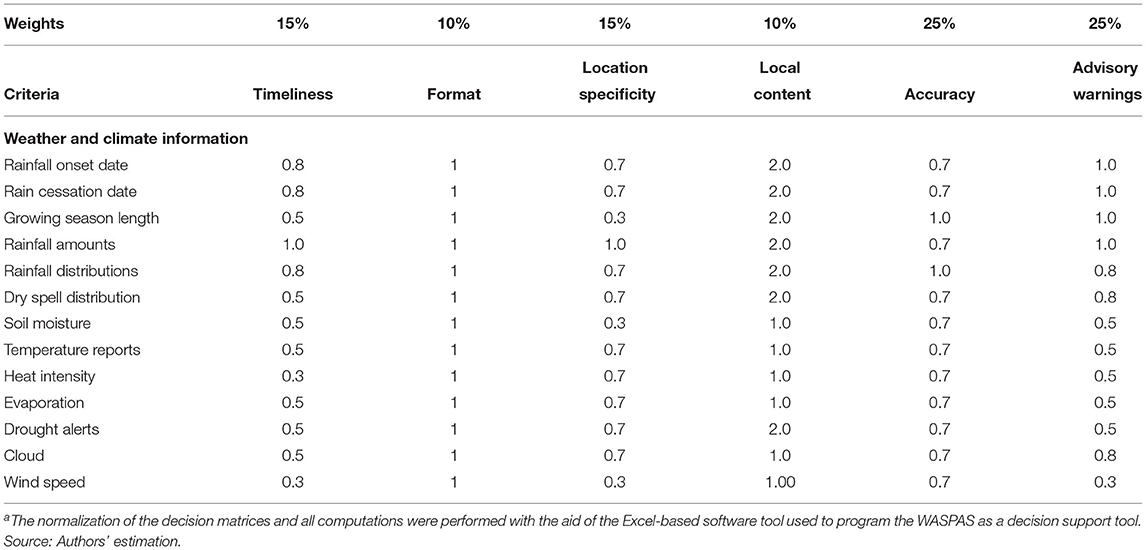
Table 8. Estimates of normalized decision matrixa and relative significances of criteria (criteria weights) (Agriculture).
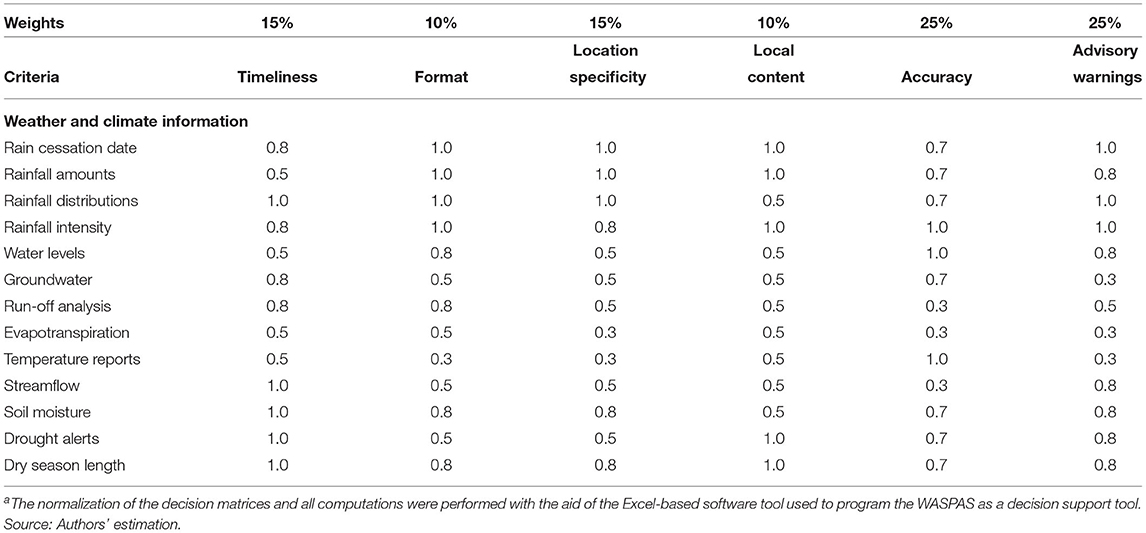
Table 9. Estimates of normalized decision matrixa in water resources and relative significances of criteria (criteria weights) (Water Resources).
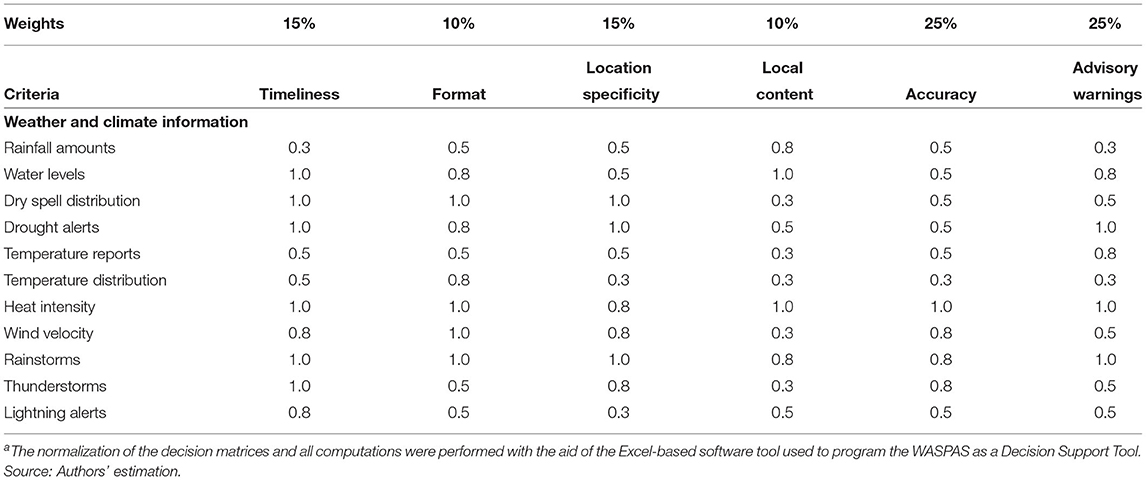
Table 10. Estimates of normalized decision matrixa and relative significances of criteria (criteria weights) (Disaster risk reduction).
The results of the multi-criteria decision-making problem (MCDM) using the WASPAS framework is presented for agriculture sector in Table 11, water resources sector in Table 12, and disaster risk reduction sector in Table 13.
Users' Needs for WCI Across key Economic Sectors
The list of criteria to be considered during the WCI assessment process has resulted in a significant finding based on proper stakeholders' direct engagement during the preparation of the inception report. These are outcomes from various interactions and discussions that limit the risk of institutional or personal bias. Given that the stakeholder comprises representatives from various WCI user groups, the identified criteria encompass a range of preferences from different categories of people. This final outcome of the analysis present the ranking of the WCI alternatives. For agriculture in Figure 4, the ranking shows rainfall amount (0.95), rainfall onset and cessation dates (0.84), and rainfall distributions (0.81) to be the most useful WCI needed by end users for them to uptake WCI products and services especially in preparing for drought risk with appropriate response arrangements. However, in the context of water resources in Figure 5, rainfall intensity (0.91), rainfall cessation date (0.89), rainfall distributions (0.87), and length of dry season (0.79) are most preferred in the water resources management sector for facilitating drought risk preparedness and response action. For disaster risk reduction in Figure 6, heat intensity (0.96), rainstorms (0.91), and drought alerts (0.78) are ranked to be the most useful WCI needed for decision-making to strengthen the adaptive capacity of users in anticipation of likely future drought hazard.
These WCI considered as the most important will assist users in reducing vulnerability to drought hazard with its associated impact on their livelihood activities in these key economic sectors. Effective drought management systems through provisions of water dams, irrigation canals, and water pump facilities require high budget implications and technical capacity, which are less available in the study area. It is clearly understood that the provision of rainfall amount, rainfall intensity, heat intensity, and rainstorms have proved to be relatively the most useful WCI that meet users' needs in the savannah belt of Nigeria. These WCI products and services will assist users in managing drought hazard by facilitating their decisions in taking appropriate preparedness actions to prevent loss and damages of agricultural livelihood investments in view of the relative importance of the criteria along with the existing users' preferences and the characteristics of WCI products and services.
This is an emerging insight for the Nigerian Meteorological Agency (NiMet) to intensify its effort toward delivering weather and climate services that are user oriented and decision driven in the savannah belt of Nigeria.
Usefulness of WCI Timescale to Users
The most preferred WCI timescales by users are described in Figure 7, thus expected to make future improvements in the value of weather forecasting and its utilization in Nigeria.
One common factor was that users need forecasts on short-to-medium timescales to facilitate resource planning for efficient utilization and management. In the disaster risk management sector, 82% of the respondents mostly preferred S2S forecast information to other timescales followed by 68% who wanted extended range forecasts and medium range forecasts. The results support the need for risk preparedness to ensure safety of the respondents through early warnings of high-impact events usually within 2 weeks to a season (White et al., 2017; Moron et al., 2018). The S2S timescales enable users with sufficient time within 2 weeks to 2 months to make adequate plans such as evacuation arrangements, and planning food and water provisions ahead of a drought crisis as well as relief materials to minimize income shrinking that might result from crop losses.
The water resources sector recorded 96% of the sampled actors who mostly wanted S2S forecasts, and 70% preferred extended range forecasts and nowcasting forecasts. These three timescales were the most relevant to domestic water users, irrigation farmers within water user associations, and water resources planners. They provide ample opportunity for adaptation response plans, which include rainwater harvesting, reservoir tanks, and smart water use technologies for irrigation ahead of likely dry spells and water stress in the savannah area. In the agricultural sector, 92% were interested in S2S forecasts, extended range forecast by 69% of the respondents, and next by 72% who wanted nowcasting hourly forecasts. Basically, the S2S timescales allow window time periods during which sufficient risk management decisions with respect to crop choices and livestock varieties, purchase of agricultural inputs, irrigation water arrangements, and efficient allocation and utilization of resources are made ahead of a farming season.
Preferred Delivery Method of Forecast Communications
The analysis of the delivery methods of receiving WCI reveals different preferences in the study area. Results from the ranking show mobile telephone, radio, agricultural extension officers, farmers' groups, and contact farmers/specialist as the most preferred delivery methods of receiving WCI by end users for them to uptake WCI products and services especially in preparing for drought risk with appropriate response arrangements. Within the context of agriculture, water resources, and disaster risk reduction, the five delivery channels are ranked to be the most useful, efficient, and convenient mode of WCI dissemination required by users for decision-making and to strengthen their adaptive capacity by preparing for anticipated future drought.
These WCI products and services will assist users in managing drought hazard by facilitating their decisions in taking appropriate preparedness actions to prevent loss and damages of agricultural livelihood investments in view of the relative importance of the criteria along with the existing users' preferences and the characteristics of WCI products and services.
The results of the multi-criteria decision-making problem (MCDM) using the WASPAS framework are presented to determine the most preferred WCI delivery channels. The estimates of normalized decision matrixa are shown in Table 14 while the ranking of the alternative methods of WCI delivery channels are presented in Table 15.
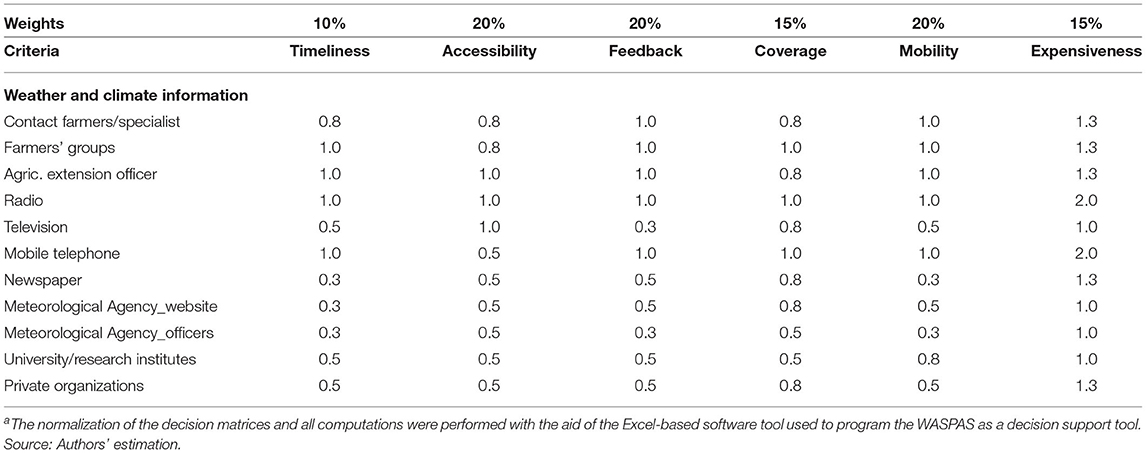
Table 14. Estimates of normalized decision matrixa and relative significances of criteria (criteria weights) (Delivery channels).
It is noteworthy that these delivery channels as the most preferred method of delivering weather information have much been linked to their opportunities that will allow for provision of advisory services that come with agro-meteorologists or agricultural extension specialists that will guide them on the next course of action in reducing their cost of adaptation. These delivery channels allow for feedbacks to correct likely errors made. Mobile phone is a communication method that is portable, fast, and has wider technology-driven pieces of information. Its efficiency has been well promoted and supported in the important sectors of disaster risk management, water resources, and agriculture on rural scale in Africa, including Nigeria. WCI through farmers' group or association is another tool of communication channel. Focus group discussions show that most of the respondents prefer to receive WCI through their associations because of social cohesion and stakeholdership that exist within the same community range. They enjoyed mutual trust and could jointly take investment risk decision. Poorly ranked delivery methods are television, newspapers, private non-governmental organizations, meteorological website, meteorological officers, and NiMet's website mainly due to their poor access.
Discussion
Determinants of Using WCI in Drought Preparedness Decisions
The outcome model shows that the positive coefficient of gender significantly increases the likelihood of farmers' decision to use WCI in drought hazard preparedness decisions. The implication of this result is that male farmers are more likely to use WCI in taking drought hazard preparedness decisions than female farmers. This result supports the argument that male-headed households are often considered to be more favored in receiving information about new technologies, thus they take risky decisions more than female-headed households. This might be associated with certain sociocultural factors such as religious or cultural factors that restrict women taking household decisions. Men are responsible for decision-making processes in the savannah belt.
The longer farmers had stayed in farming as a primary mean of livelihood, the more likely that they would use WCI in drought hazard preparedness decisions. This result is well connected to the fact that farmers have acquired experiences over time with understanding of the changing ecological characteristics of their areas, and the incidence of losses of their agricultural investments from the shock of severe dry spells whenever they are ill-prepared. They have also practiced different indigenous coping strategies over the years, thus they are aware of the strategies that work for them or those that had failed. The current speed of aridity arising from early cessation and dry spells has modified known variability patterns such that farmers have been confronted with economic losses they are not equipped to handle, despite their farming experience. This implies the need for anticipatory and planned adaptation as drought hazard preparedness to prevent losses at a local scale. Farmers' income increases the likelihood they will use WCI climate-smart decisions by an infinitesimal change. This is likely attributed to scale of their marginal productivity since majority of the farmers are predominantly medium-scale farmers. Hence, farmers with higher income are more likely to give trial to drought hazard preparedness as a safety net for climate protection to prevent or reduce potential future losses.
Increasing erratic rainfall pattern observed by respondents was found to increase farmers' likelihood to use WCI in drought hazard preparedness in the savannah zone. Increasing magnitude of unpredictability, that is, climate variability, is increasing farmers' propensity to respond early to climate-smart options toward protection and enhancing their adaptive capacity. The inverse coefficient of farmers' group membership implies that the more farmers become members to group associations, the less likely they will use WCI in their drought hazard preparedness plans. Local farmers are known for their loyalty and long attachment to their associations by trusting the decision-making pattern existing within their networks. They are more likely to implement a group/joint safety net in case of adverse weather conditions such as a slow event as that of drought. This explains the reason why it would significantly reduce the probability of using WCI in drought hazard preparedness planning in the study area.
The negative coefficient of distance to weather station also explains that proximity to meteorological station will boost farmers' confidence in WCI provided in their localities. The farther a farming community is away from the nearest weather station, the less likely they will use WCI in taking climate-smart actions. Farmers prefer to trust warning information provided by climate information service providers from a meteorological station sited close to their communities. They are more interested in warning information from WCI that are specific to their farm geographies and match with their location or climatological conditions, rather than general WCI over a large region being communicated. In locations where weather stations are sited, average distance of meteorological stations to rural communities is too far as observed by end users. The problem of unfit and inappropriate WCI within communities thereby explains reasons for the distance of meteorological stations to significantly reduce the probability of using WCI in preparing ahead of potential drought hazard in the study area.
For the selection model, only education of farmers, access to extension training services, and ownership of simple mobile handset device showed positive significant effects on access to WCI. Education is an important factor that determines access to early warnings from WCI. Farmers' education has a positive significant effect on farmers' access to WCI, thus as respondents become more educated, it is more likely that they will have more access to weather information. Their ability to understand weather predictions and quickly adjust their management decisions is more enhanced to meet local climate changes based on their better knowledge of present and future weather conditions. Extension training services show a positive significant effect on respondents' access to WCI early warnings. The more respondents have contact with extension training officers, the more likelihood that they will have access to WCI early warnings. Periodic extension education and training services serve as opportunities to share up-to-date information on fluctuations in weather parameters and appropriate advisory services on weather-related managements. Functional extension service system has great potential in facilitating early action decisions on disaster risk preparedness and management.
Ownership of simple mobile handset device also has a significant positive effect on access of the respondents to WCI. Increasing ownership of simple mobile telephones will increase the likelihood of access of the respondents to early warnings from WCI. When forecasts are made such as rainfall forecasts, and advisory agricultural calendars and drought alerts are communicated via text messages, it increases spatial coverage within a relatively short time. Such text message information can be revisited several times during a hazard preparedness decision process. This is an important driver of access to early warnings from WCI for climate-smart decisions.
Users' Preferences for WCI in Drought Preparedness and Response
Given that the disaggregated results reveal that majority of the end users of WCI are from the water resources sector especially Fadama farmers who are mainly irrigation farmers, and next are users in agriculture, irrigation planning against dry spells and likely long droughts are taken seriously to avert loss and damage of agricultural investments. These results supported previous studies on reasons for low use of WCI in Africa. Kumar et al. (2020) have expressed the need for more accurate, time-specific, trusted, and actionable climate information. This is expected to facilitate high potential, improve use, and need for climatic information services if tailored for farmers' needs for improving agricultural decision-making (Niang, 2011). Nkiaka (2019) observed that low awareness, understanding, and accessibility of WCI, low relevance and users' capacity to take decision, distrust in forecasts, and institutional barriers such as fragmented institutional framework with overlapping roles are major barriers to uptake of weather and climate information in sub-Saharan Africa (Schaer and Hanonou, 2017). Singh et al. (2018) further explained that despite an increasing number of climate model simulations, there is largely poor usage of WCI because the information produced and disseminated is often irrelevant and not reliable to inform decision-making at local scale, particularly for farmers and government agencies as secondary users or planning purposes in managing climate risks. Anders and Stein (2016) observed that consistency, reliability, and relevance of the WCI to farmers' needs were fundamental in integration of climate information into household decision-making.
Ziervogel et al. (2010) show similar results of low use of weather forecast information due to delay in access to short-term decision-making forecast services and doubting its reliability. Lemos et al. (2012) identified disconnection between weather service providers and users as one key constraint limiting the use of climate information in Africa. Farmers also expressed their worries about the inability of the agricultural extension agents in disseminating timely weather and climate information on a wide coverage due to lack of funding for such special role. Ouedraogo et al. (2018) concluded that huge operational cost involved right from forecast production to dissemination and training of users for effective use of weather and climate information as major institutional barriers to the wide coverage and use of climate forecast information.
Appropriateness of WCI
The appropriateness of WCI needed by the primary users across the major climate-sensitive sectors reveals that the specific WCI needs are rainfall onset and cessation, and drought alerts to decide types of adaptation measures in preparing for likely dry spells and loss of standing crops. This is very important to food crop farmers in taking various agri-investment expenditures during pre-cropping season and crop management decisions afterwards especially when to start land preparation, seed planting, type of weeding, and pest control selections, and agricultural water use management for crop management operational activities during the dry season.
Rainfall onset and cessation forecasts provide an opportunity for sustainable water and irrigation system planning, which encourage women's participation in all-year-round agricultural income livelihoods that are the largest percentage of food producers and domestic water users by keeping safe domestic water in the savannah area. The results also underscore the need for enhancing water resources for irrigation development. WCI on rainfall onset and cessation are helpful to develop appropriate measures that will enhance irrigation of crops that are suitable for cultivation and increase the length of growing season in the study area. These results are critical policy pointers that meteorological service providers should engage user community in these climate-sensitive sectors to identify their actual needs and form an alliance through which WCI can be co-produced for specific locations and fit into different agroecological zones. Meteorological agencies should endeavor to use agro-meteorological information for packaging WCI capable of taking timely management decisions such as drought-resistant crops and livestock, and develop a drought contingency plan with a range of scales from days to entire cropping season in the water and agricultural sectors.
The results obtained agree with those of Carr et al. (2017) that rural users of WCI are less concerned with the sophistication associated with scientific weather monitoring or numerical prediction capacity of forecasters but interested in receiving useable weather information that are location specific and provided with robust advisory services that will assist them in taking informed decisions on their agricultural investments. It implies that it is difficult for rural users to articulate their needs around numerous WCI products and services produced by meteorological agencies, even if unavailable (FAO, 2019d). They are faced with numerous socio-economic barriers to understand diverse weather services being produced by the forecasters. What is important is the extent of using WCI, which depends on usability of the WCI and low complexity in decision-making, not the varying amount of information made available to users (Anders and Stein, 2016). Service providers should therefore leave out evaluations of weather dynamics but focus on the simplicity of communicating weather reports. This approach would enhance the use of different WCI alternatives of information to allow for quick decision-making. In emphasizing the characteristics of useful types of weather and climate information, forecast should be relevant or useful for decision-making on a spatial scale. The information needs to contain predictions, threat assessments, warnings and alerts, and guidance for appropriate preparedness decisions (Amadi and Chigbu, 2014).
Results obtained are also in line with Tall et al. (2012) who noted that seasonal forecast information issued early allows disaster risk managers to make advance preparation for anticipated hazards, hence science-based early warning informed decisions usually trigger action in anticipation of forecast events, thereby moving decision-makers to action and overcome traditional barriers to the use of climate information. The sub-Saharan Africa has been identified as one of the most susceptible regions to variability in the length of growing season and very low access to basic resources such as irrigation water. Smallholder farmers require different types of climate information at different periods during the farming season. Similar studies have established that WCI is critical in building adaptive capacity of farmers in addressing climate risks. Lugen et al. (2018) observed that smallholder farmers need information on the expected rainfall amount and its distribution as well as the length of the growing season provided through short range information such as sub-seasonal and seasonal forecasts to make important decisions on the range of actions, from crop types to plant for the season. The number of rainy days and dry spells are also crucial in making decisions on when to plant, disease management, and harvesting times (Coulibaly et al., 2015). The onset and cessation of rainy season is of utmost significance to agriculture in many West African countries because the sector is largely rain fed (Sobowale et al., 2016).
Rainfall onset and cessation dates have implication for food security and water resource management. Onset date information is highly valuable for local agricultural production especially for rainfed crop farmers. The knowledge about length of cropping seasons are valuable for planning, organization, and implementation of agricultural activities—timely preparations in mobilizing labor, seeds, and other inputs. It will be helpful for farmers to improve their decisions about selection of crop types and varieties. Informed farmers can also reduce the operational costs associated with re-planting process, therefore optimizing their investments. Likewise, changes in onset and cessation dates affect livelihood activities of men and women differently based on gender differences and capacity to absorb stress and shocks. Women usually engage in subsistent agriculture during cropping season but are helpless during prolonged dry seasons while men do diversify into non-farm alternative livelihoods. They oftentimes bear the major burden of water shortages for household utilization and irrigation agriculture due to rainfall changes, as previously concluded by Mbajiorgu et al. (2017).
Tembo-Nhlema et al. (2019) explained that participatory planning between weather service providers and users at early stages of forecast development can generate information that is credible, legitimate, and salient by potential users. User engagement is an effective approach that could bridge the divide between producers and users. Weather scientists are not always the best at understanding user needs or communicating, which justifies co-production partnership with user stakeholders (Porter and Dessai, 2017). Rather than expecting much of dissemination responsibilities from climate information producers, there may be a role for user engagement, boundary agents, or knowledge brokers who can bridge the divide (Cvitanovic et al., 2015; Guido et al., 2016). Co-producing weather forecast information has the benefits of ensuring scientific credibility, legitimacy, and salience to users (Buontempo et al., 2014).
These empirical findings are in line with FAO (2019a), which ascertained that the two most important elements influencing crop growth and development are temperature and water availability. They are both needed in facilitating decisions related to crop management practices and optimizing the production or minimizing the risk of the farming systems in response. Various studies have further highlighted that the information produced does not necessarily meet user needs, in terms of timeframe, spatial scale, and applicability (Vincent et al., 2016, 2017; Singh and Singh, 2017) while also reiterating the fact that improved weather information alone is not adequate but needs to be useful and usable to decision-makers (Dilling and Lemos, 2011; Lemos et al., 2012; Jones et al., 2015).
Amadi and Chigbu (2014) further underscore the need for accurate and timely climate information and demonstrate that the management of current climate-related risks and long-term adaptation requires customization of climate information so that it would be relevant to end users, helping to prevent climate extremes from becoming disasters and threats to livelihoods. Forecast-based information issued early in the year allows disaster risk managers to make advance preparation for anticipated hazards, pre-position disaster relief items in strategic locations across communities and families, update flood contingency plans, and alert vulnerable communities and decision-makers in reducing number of lives, property, and livelihoods to be lost (Tall et al., 2012; Merz et al., 2020). The National Research Council (1999) stated that increase in forecast skill is not a panacea, given that improved forecasts remain far from perfect but often ill-suited for direct use in decision-making. The usefulness of forecasts is dependent on both accuracy and their relationship to recipients' informational needs and coping strategies.
One major hindrance found in this study to opportunities of WCI users is the poor access to some important and highly consequential WCI, however which to the meteorological agencies they look negligible, for instance, early warnings and advisory information temperature, water levels, evaporation, and windstorms. Hence, most often, meteorological agencies do not make robust early warnings about them available to the user community. Antwi-Agyei et al. (2021) observed that among those that have accessed some kind of WCI, it was noticed that still the majority were just receiving WCI relating to rainfall with a fewer number of those who had received information on other vital WCI products and services, especially temperature and windstorms.
Timescale of WCI in Facilitating Preparedness
A number of recent empirical studies carried out on the potential of subseasonal-to-seasonal (S2S) forecasts in the planning of activities in climate-sensitive sectors at a regional or national scale include adaptation plans that may be necessary in solving climate variability and climate change problems such as droughts and floods as extreme weather shocks (Olaniyan et al., 2018). Haigh et al. (2015) explained that historical climate information and long-term climate outlooks are less useful in agricultural risk management compared with current weather, short-term forecasts, or monthly climate projections, even if they may be more useful to certain types of decision-making. FAO (2019b) had also identified that during the pre-season, farmers need weather information to determine the most suitable crop(s) for a particular region based on crop water requirements before a season starts and at the end of the season. Seasonal climate outlooks for specific agro-climate zones are needed to facilitate adaptation conditions due to inherent uncertainty. Vitart et al. (2017) observed that the fundamental problem of limiting usability of forecasts has been a concern for development actors. The medium range time-scales appear too short for any meaningful mitigating action to be taken, and there exists a gap between the medium- and long-range time-scale forecasts. It is unfortunate because many vital management decisions with regards to agriculture and food security, water management, and disaster risk reduction, health, etc. are made within this gap. As demands for reliable weather and climate forecasts are increasing, forecasts from S2S models are regarded as a new frontier for atmospheric predictability research to improve users' decision-making processes in many key weather and climate-dependent socio-economic sectors.
Bacci et al. (2020) found that users of agro-meteorological forecasts were highly interested in receiving 2 weeks to a season forecast information for local decision-making processes in crop management especially for extreme weather phenomena with a strong impact on crops and livestock. Weather forecast of very intense phenomena and dry spells during the next 2 weeks to about 3 months are specifically appreciated. It is therefore more beneficial and relevant to tailor weather and climate information to specific end users' needs. Ouedraogo et al. (2018) have also observed that the most useful and needed weather and climate information in the agriculture sector include cumulative rainfall and dry spells every 10 days (decadal frequency) prior to the beginning of the season, seasonal forecast once in a year, and the onset and cessation dates once in a year. Throughout the season, 10-day agro-meteorological advices on better adaptation of farmers' practices, and 3-day weather forecasts for rainfall and temperature focus on extreme events such as drought forecast (FAO, 2019c).
In numerous studies conducted by White et al. (2017), it is observed that users are used to short- to medium-term weather forecasts in taking decisions compared with long-term scales. The S2S weather and climate forecasts have potentials to support decision-makers in protecting life and property, production resources, and wellbeing. S2S timescales could provide window opportunity of decision-making in drought disaster management using short-to-long-range predictions (Goddard et al., 2014). Seasonal forecasts provide monitoring information and early contingency planning such as food relief purchases and training; subseasonal forecasts provide the early warnings and alerts for preparedness while short-range weather forecasts facilitate resettlements and distribution of aid (Vitart, 2014). This strengthens capacity of disaster risk reduction managers in adjusting and adapting accordingly to commence preparedness activities as well as supporting important shift to short-term actions when drought shock strikes. It offers an opportunity for disaster risk reduction managers to track the progress of the slowly supporting transition from seasonal outlooks to weather forecasts to inform both drought risk planning and systematic response (Tadesse et al., 2016). Many of the disaster preparedness actions that can be taken based on risk of extreme events require time to activate, some of which include purchasing disaster response supplies such as food, water, and drug during drought that can take several weeks (Boston Consulting Group, 2015).
White et al. (2017) found that S2S weather and climate forecasting has the capacity to fill the gap between short-range weather services and long-range seasonal outlooks for water resources management. Extended range of lead time enables preparedness and plans decisions to be made in a range of sectors including continuous monitoring of forecasts, updating community warnings, initiating preparedness activities, revising water allocations, and activating water conservation practices. WSWC CDWR (2016) reaffirmed that S2S forecasts on the probability of evaporation, runoff, or likelihood of atmospheric river events are useful for drought control in water resources management. Prior to the beginning of the seasons, Fadama farmers in the established water user associations and water managers can make farm irrigation infrastructure planning, water allocations during drought, and hydropower scheduling decisions on water supply in reservoirs to sustain all-year-round agricultural productions in the savannah area. In the agricultural sector, S2S forecast timescale on rainfall departures also have applications in managing drought in the food security sector by making transportation plans for large quantities of food during food crisis when it happens (White et al., 2017). It gives reliable longer-range forecasts, which allow users to take risk reduction actions against extreme events such as droughts.
Efficient Delivery Channels of WCI
It was previously observed that most of the WCI communication methods were poorly accessible to most farmers because they are costly, weak in coverage, and lack feedbacks in the interiors of rural villages. A limited number of respondents have television or access to newspapers in the interior of the rural villages. The low level of education and civilization have also constrained farmers in decoding information received through WhatsApp services and websites, while absence of agricultural extension workers was observed as a key barrier. These findings agreed with other studies that effectiveness of WCI depends strongly on the disseminating systems, distribution channels, recipients' modes of understanding and perception about the information sources, and format of presentation. Forecast interpretations are likely to be strongly affected by individuals' pre-existing mental models such that when forecasts turn out to be wrong, they have strong negative influences on the future use of forecast information (National Research Council, 1999). Future improvements in the use of WCI have to focus on combining the use of contact experts/specialists, mobile phones, farmers' groups/associations, and redefined agricultural extension officers as major pathways to forecast information communication. This presents further evidence that weather service providers should consult and engage users when developing WCI product and services to ensure relevance and usability.
Perspectives And Outcomes
This paper has some interesting perspectives provided for the WCI users, service providers, and private support institutions. The major determinants of the use of WCI by rural households are male gender, farmers' experience, income, and persistent incidence of erratic rainfall in the study area. Male farmers have more propensity to use WCI more than female famers in taking drought preparedness and response. Likewise, farmers' experience would increase their likelihood to use WCI. This is reasonable because good and bad previous experiences and increasing vulnerability to weather variations will influence continuous usage. As farmers' income gets better, they are more inclined to use WCI in decision-making because they have economic capacity to sustain the cost of adjustment. Persistent frequency of erratic rainfall increases the use of WCI as drought preparedness increases. However, as group membership improves and the unit distance of meteorological station is farther away from communities, their interest on the usage of that WCI decreases. They rely on the local information received, safety nets, and local interest-free credit arrangement of their association. However, the purpose of establishing group membership should be re-modified to enable communities to benefit from early warnings from the WCI, thereby ensuring preparedness and protection from potential drought hazard.
There is still a relatively low uptake of WCI among rural communities who dominate the largest percentage of the population. Users of WCI accounted for only 33.0% of the respondents who reported use of WCI in taking agricultural decisions; 43.0% of the respondents have used WCI to enhance water use decision planning in the water resources while 26% of the respondents used WCI to plan ahead of likely drought shock, as disaster risk reduction. Multi-criteria (MCA) decision-making analysis provides an accurate ranking of alternative WCI to determine the usefulness of the many WCI products and services through the Meteorological Office, thereby identifying what users considered as useful WCI for decision-making across key economic sectors.
Rainfall amount, rainfall onset and cessation dates, and rainfall distributions are the most useful WCI needed by end users for them to uptake WCI products and services especially in preparing for drought risk with appropriate response arrangements in the central savannah belt of Nigeria. Regarding water resources, rainfall intensity, rainfall cessation date, rainfall distributions, and length of dry season are the most useful WCI for water resource management while the ranking shows that heat intensity, rainstorms, and drought alerts are ranked to be the most useful for users in disaster risk reduction and in fostering resilience toward anticipated future drought hazard. The drying conditions of the study are explained reasons for the interest in rainfall amounts and the distributions are needed to plan for drought preparedness actions, water supply issues for domestic purposes and agricultural water supplies, and raising emergency alerts. They are most important to decide when to start land preparation and seed planting in the agriculture sector, and water supply planning and drought alerts by water planners in the water resources. These WCI are considered as the most important that will assist users in reducing their vulnerability to drought hazard with its associated impact on their livelihood activities in those key economic sectors.
The most useful WCI timescales across different stakeholders are identified as short range (1–3 days) to medium (4–10 days) timescales to facilitate resource planning for efficient utilization and management. In all the sectors, subseasonal-to-seasonal (S2S) information is the most highly rated. This study supports the need for early warnings of high-impact events usually within 2 weeks to a season. S2S timescales allow sufficient time (2 weeks to 2 months) to enable users to make adequate risk preparedness and adaptation plans that will minimize economic damage and losses. The users' most preferred delivery methods of receiving WCI are mobile telephone, radio, agricultural extension officers, farmers' groups, and contact farmers/specialist for efficiency and convenient criteria in enhancing users' decision capacity to uptake WCI products and services.
The emerging outcome of this paper is that there is a need for a policy drive that will make WCI forecasting systems include impact-based forecast estimates and response advisory across a wide range of natural hazards. There is a high demand for short-range forecasts, especially the sub-seasonal to seasonal forecasts for operational activities in water resource management and the intra-seasonal forecasts in agriculture. NiMet, the Meteorological Agency mandated by the Federal Government for the provision of weather and climate services, should liaise with the primary and secondary users in co-developing close-range WCI. The Agency should link with user groups in various farming communities especially to incorporate male farmers' groups with considerable years of farming experience of the agro-ecology to enable them to bring their local experiences into co-production of WCI. This initiative will produce WCI that are on-demand and location specific. Second, the Agency should shift its focus to the production of rainfall amount, rainfall onset and cessation dates, and rainfall distributions for agriculture users; rainfall intensity, rainfall cessation date, rainfall distributions, and length of dry season for water resources users; and heat intensity, rainstorms, and drought alerts for the disaster risk reduction. These are WCI that actually meet user needs in Central-Southern Nigeria, and their availability will fast track rapid uptake in their various decision-making processes in the region. Packaging subseasonal to seasonal (S2S) and medium-range (4–10 days) WCI timescale should be given utmost attention by the Meteorological service providers to make their products and services receive wide coverage of various users.
This study also recommends that the National Meteorological Office should have a collaborative engagement with contact farmers, specialists, and agricultural extension workers as supportive pathway to disseminate WCI. Such arrangement will facilitate rapid uptake of WCI in operational decision-making among rural communities due to the strong socio-cultural relationships and exchange that exist among rural people. NiMet should have a Memorandum of Understanding (MoU) with telecommunication operators to take advantage of their massive mobile telecommunication installations in reaching more rural households with WCI on their mobile phones. Such initiatives will enable the possibility of producing location-specific WCI locations, strengthening local delivery arrangements of WCI products and services, and re-designing feedback mechanisms between users and service providers to improve on their services at local scale. A seamless collaborative effort in bringing scientific outputs and users' needs together will increase the utility of weather forecast information through systematic efforts. NiMet should improve on its engagement with the stakeholders, principally the agricultural extension and planning office, water management authorities, and disaster risk and emergency response personnel as partner institutions. These policy actions in designing robust collaborative framework for useable information based on user needs will improve the use of WCI in managing decision points against probable extreme events and mainstream preparedness into an existing decision-making apparatus of rural communities in Central-Southern Nigeria.
Data Availability Statement
The raw data supporting the conclusions of this article will be made available by the authors, without undue reservation.
Author Contributions
DA and JM developed the concept idea and designed the methodology. DA collected the field data and wrote the article. DA performed the data analysis while EA provided insights on meteorological aspect of the analysis. JM, AT, and PA-A reviewed and edited the article. All authors contributed to the article and approved the submitted version.
Funding
This work was supported by UK Research and Innovation as part of the Global Challenges Research Fund (GCRF) in the African Science for Weather Information and Forecasting Techniques (GCRF African-SWIFT) programme, Grant Number NE/P021077/1.
Conflict of Interest
The authors declare that the research was conducted in the absence of any commercial or financial relationships that could be construed as a potential conflict of interest.
Publisher's Note
All claims expressed in this article are solely those of the authors and do not necessarily represent those of their affiliated organizations, or those of the publisher, the editors and the reviewers. Any product that may be evaluated in this article, or claim that may be made by its manufacturer, is not guaranteed or endorsed by the publisher.
Acknowledgments
We expressed our gratitude to Prof. Andrew Dougill at the Faculty of Environment, University of Leeds, UK who secured the research fund under the GCRF African-SWIFT programme. Our deep appreciation to Prof. Jerome Omotosho at the WASCAL Graduate Research Programme of West African Climate Systems, Federal University of Technology Akure, Nigeria for excellent advice and mentorship. We would also like to thank all organizations and individuals in Nigeria and Kenya who provided us with good data and information during the field work for this study.
References
Abdullahi, H. G., Fullen, M. A., and Oloke, D. (2016). Socio-economic effects of drought in the semi-arid sahel: a review. Int. J. Adv. Sci. Eng. Technol. 1, 95–99. Available online at: http://iraj.in/journal/IJASEAT/volume.php?volume_id=224
Adeaga, O. (2011) Low-flow frequency analysis in part of the Lower Niger River. Int. Assoc. Sci. 340, 207–213.
Adenle, A. A., Ford, J. D., Morton, J., Twomlow, S., Alverson, K., Cattaneo, A., and Ebinger, J. O. (2017). Managing climate change risks in africa—a global perspective. Ecol. Econ. 141, 190–201. doi: 10.1016/j.ecolecon.2017.06.004
Ali, A., and Abdulai, A. (2010). The adoption of genetically modifed cotton and poverty reduction in Pakistan. J. Agricult. Econ. 61, 175–192. doi: 10.1111/j.1477-9552.2009.00227.x
Alinezhad, A., and Khalili, J. (2019). “WASPAS Method,” International Series in Operations Research and Management Science, in: New Methods and Applications in Multiple Attribute Decision Making (MADM) (New York, NY: Springer), pp. 93–98.
Amadi, S. O., and Chigbu, T. O. (2014). The need for accurate and timely weather and climate services in a developing economy: nigeria in perspective. J. Curr. Res. Sci. 2, 680–686. Available online at: www.jcrs010.com
Amwata, D. A., Omondi, P. O., and Kituyi, E. (2018). Uptake and use of climate information services to enhance agriculture and food production among smallholder farmers in eastern and Southern Africa region. Int. J. Adv. Res. 6, 859–873. doi: 10.21474/IJAR01/7106
Anders, D. S., and Stein, D. K. (2016). Use of Online Weather information in everyday decision-making by laypeople and implications for communication of weather information. Meteorologic. Appl. 23, 650–662. doi: 10.1002/met.1588
Antwi-Agyei, P., Amanor, K., Hogarh, J. N., and Dougill, A. J. (2020). Predictors of access to and willingness to pay for climate information services in north-eastern Ghana: a gendered perspective. Environ. Develop. 100580. doi: 10.1016/j.envdev.2020.100580
Antwi-Agyei, P., Andrew, J., Dougill, A. J., and Abaidoo, R. C. (2021). Opportunities and barriers for using climate information for building resilient agricultural systems in Sudan savannah agro-ecological zone of north-eastern Ghana. Clim. Serv. 22, 100226. doi: 10.1016/j.cliser.2021.100226
Antwi-Agyei, P., Fraser, E. D. G., Dougill, A. J., Stringer, L. C., and Simelton, E. (2012). Mapping the vulnerability of crop production to drought in ghana using rainfall, yield and socioeconomic data. Appl. Geogr., 32, 324–334. doi: 10.1016/j.apgeog.2011.06.010
Apgar, J. M. P. J., Cohen, B. D., Ratner, S., De Silva, M.-C., Buisson, C., et al. (2017). Identifying opportunities to improve governance of aquatic agricultural systems through participatory action research. Ecol. Soc. 22, 9. doi: 10.5751/ES-08929-220109
Awolala, D. O. (2018). “Climate smart adaptations in the african tropics: scaling weather information for decision support outcomes in Nigeria savannahs,” in Handbook of Climate Change Resilience, eds Leal Filho W. (New York, NY: Springer), p. 1–33.
Awolala, D. O., Ajibefun, I. A., Ogunjobi, K., and Miao, R. (2021). Integrated assessment of human vulnerability to extreme climate hazards: emerging outcomes for adaptation finance allocation in Southwest Nigeria. Clim. Develop. 21, 925. doi: 10.1080/17565529.2021.1898925
Ayanlade, A., Radeny, M., Morton, J. F., and Muchaba, T. (2018). Rainfall variability and drought characteristics in two agro-climatic zones: an assessment of climate change challenges in Africa. Sci. Total Environ. 630, 728–737. doi: 10.1016/j.scitotenv.2018.02.196
Bacci, M., Baoua, Y. O., and Tarchiani, V. (2020) Agro-meteorological forecasts for smallholder farmers: a powerful tool for weather-informed crops management in the sahel. MDPI Sustain. 12, 3246. doi: 10.3390/su12083246
Bagočius, V., Zavadskas, K. E., and Turskis, Z. (2013). Multi-criteria selection of a deep-water port in Klaipeda. Procedia Eng. 57, 1877–7058. doi: 10.1016/j.proeng.2013.04.021
Baumüller, H. (2016). “Agricultural service delivery through mobile phones: local innovation and technological opportunities in Kenya,” in Book: Technological and Institutional Innovations for Marginalized Smallholders in Agricultural Development, (New York, NY: Springer International Publishing), eds F.W. Gatzweiler and J. von Braun., p. 9.
Boston Consulting Group (2015). UNICEF/WFP Return on Investment for Emergency Preparedness Study. Boston Consulting Group: Boston. Available online at: http://www.unicef.org/publications/index_81164.html (accessed February 08, 2021).
Brasseur, G. P., and Gallardo, L. (2016). Climate services: lessons learned and future prospects. Earth's Fut. 4, 79–89. doi: 10.1002/2015EF000338
Brinkhoff, T. (2016). Open street map data as source for built-up and urban areas on global scale. Int. Archiv. Photogrammetr. Rem. Sens. Spat. Inform. Sci. 41, 557–564. doi: 10.5194/isprsarchives-XLI-B4-557-2016
Britz, M. (2021). Africa: Climate Services are Crucial for Climate Adaptation but Underfunded. Washington, DC: International Monetary Fund and World Bank Group. Available online at: https://allafrica.com/stories/202110080890.html
Buontempo, C., Hewitt, C. D., Doblas-Reyes, F. J., and Dessai, S. (2014). Climate service development, delivery and use in Europe at monthly to inter-annual timescales. Clim. Risk Manage. 6, 1–5. doi: 10.1016/j.crm.2014.10.002
Carr, E., Goble, R., Rosko, H. M., Vaughan, C., and Hansen, J. (2017). Identifying Climate Information Services Users and their Needs in sub-Saharan Africa: A Learning Agenda. A Learning Agenda on Climate Information Services in sub-Saharan Africa (USAID).
Cho, R. (2019). State of the Planet: How Climate Change Impacts the Economy. Earth Institute, Columbia University, USA. Available online at: https://Blogs.Ei.Columbia.Edu/2019/06/20/Climate-Change-Economy-Impacts/ (accessed November 08, 2021).
Clark, G. L., and Marshall, J. C. (2002). Decision making models of the real world and expertise. Environ. Plann. A: Econ. Space 34, 1139–1146. doi: 10.1068/a3575
Clements, J., Ray, A., and Anderson, G. (2013). The Value of Climate Services across Economic and Public Sectors: A Review of Relevant Literature. United States Agency for International Development (USAID): Washington. Available online at: http://www.climate-services.org/wp-content/uploads/2015/09/CCRD-Climate-Services-Value-Report_FINAL.pdf (accessed March 30, 2021).
Climate Scorecard (2019). Nigeria Listed as One of the 10 Most Climate Vulnerable Countries. Available online at: https://www.climatescorecard.org/~2018/11/nigeria-listed-as-one-of-the-10-most-climate-vulnerable-countries/ (accessed March 28, 2021).
Coulibaly, Y. J., Kundhlande, G., Amosi, N., Tall, A., Kaur, H., and Hansen, J. (2015). What Climate Services Do Farmers and Pastoralists Need in Tanzania? Baseline study for the GFCS Adaptation Programme in Africa. CCAFS Working Paper no. 110. Copenhagen, Denmark: CGIAR Research Programme on Climate Change, Agriculture and Food Security (CCAFS). Available online at: https://ccafs.cgiar.org/resources/publications/what-climate-services-do-farmers-and-pastoralists-need-tanzania (accessed January 29, 2021).
CRED UNISDR (2020). Economic Losses, Poverty and Disasters: 1998-2017. Global report of the Centre for Research on the Epidemiology of Disasters (CRED) and the United Nations Office for Disaster Risk Reduction. Available online at: https://www.preventionweb.net/files/61119_credeconomiclosses.pdf (accessed January 29, 2021).
Cutter, S. B., Osman-Elasha, J., Campbell, S.-M., Cheong, S., McCormick, R., et al. (2012). “Managing the risks from climate extremes at the local level,” in Managing the Risks of Extreme Events and Disasters to Advance Climate Change Adaptation: A Special Report of Working Groups I and II of the Intergovernmental Panel on Climate Change (IPCC), eds Field, C.B., V. Barros, T.F. Stocker, D. Qin, D.J. Dokken, K.L. Ebi, et al. (New York, NY, Cambridge: Cambridge University Press), pp. 291–338.
Cvitanovic, C., Hobday, A. J., van Kerkhoff, L., Wilson, S. K., Marshall, N. A., and Dobbs, K. (2015). Improving knowledge exchange among scientists and decision-makers to facilitate the adaptive governance of marine resources: review of knowledge and research needs. Ocean Coast. Manage. 112, 25–35. doi: 10.1016/j.ocecoaman.2015.05.002
Deressa, T., Hassan, R. M., and Ringler, C. (2008). Measuring Ethiopian farmers' vulnerability to climate change across regional states. Int. Food Policy Res. Instit. 00806, 1–38. Available online at: https://ebrary.ifpri.org/digital/collection/p15738coll2/id/13927
Dilling, L., and Lemos, M. C. (2011). Creating usable science: Opportunities and constraints for climate knowledge use and their implications for science policy. Global Environ. Change 21, 680–689. doi: 10.1016/j.gloenvcha.2010.11.006
Ekstrom, J. A., Susanne, C. M., and Margaret, T. (2011). Barriers to Climate Change Adaptation: A Diagnostic Framework. California Energy Commission. Publication Number: CEC-500-2011-004.
Elijah, A., Ikusemoran, M., Nyanganji, K. J., and Mshelia, H. U. (2017). Detecting and monitoring desertification indicators in Yobe State, Nigeria. J. Environ. Issues Agricult. Develop. Countr. 9, 22–34. Available online at: https://www.icidr.org/jeiadc-vol9no1-april2017/Detecting-and-Monitoring-Desertification-Indicators%20in-Yobe-State-Nigeria.pdf
Emeribe, C. N., Uwadia, N. O., Fasipe, O. A., and Isagba, E. S. (2017). Inter-decadal nature of rainfall character over sudano-Sahel, North-West Nigeria: AFri. Res. Review. 11, 55–73. doi: 10.4314/afrrev.v11i4.6
FAO (2015). The Impact of Natural Hazards and Disasters on Agriculture, Food Security and Nutrition, pp. 1–54. Available online at: http://www.fao.org/3/a-i5128e.pdf (accessed November 8, 2021).
FAO (2016). The State of Food and Agriculture: Climate Change, Agriculture and Food Security. ISBN 978-92-5-109374-0. Available online at: http://Www.Fao.Org/3/I6030e/I6030e.Pdf (accessed November 8, 2021).
FAO (2018). The Impact of Disasters and Crises on Agriculture and Food Security. Available online at: http://www.fao.org/3/I8656EN/i8656en.pdf (accessed November 08, 2021).
FAO (2019a). The State of Food Security and Nutrition in the World - Safeguarding Against Economic Slowdowns and Downturns. Rome: Food and Agriculture Organization of the United Nations. Available online at: http://www.fao.org/3/ca5162en/ca5162en.pdf (accessed November 12, 2021).
FAO (2019b). Scaling up Agroecology to achieve the sustainable development goals. Proceedings of the Second FAO International Symposium. Rome: Food and Agriculture Organization of the United Nations. Available online at http://www.fao.org/3/ca3666en/ca3666en.pdf (accessed November 12, 2021).
FAO (2019c). Council. 163rd Session. The Ten Elements of Agroecology. Document CL 163/13 Rev.1. Rome: Food and Agriculture Organization of the United Nations. http://www.fao.org/3/ca7173en/ca7173en.pdf (accessed November 12, 2021).
FAO, IFAD, UNICEF, WFP, and WHO. (2018). The State of Food Security and Nutrition in the World 2018. Building Climate Resilience for Food Security and Nutrition. Rome: FAO. Available online at: http://www.fao.org/3/I9553EN/i9553en.pdf (accessed November 08, 2021).
FAO (2019d). Handbook on Climate Information for Farming Communities – What Farmers Need and What is Available. Rome. 184 pp. Licence: CC BY-NC-SA 3.0 IGO (accessed March 27, 2021).
Garba, H., Ibrahim, A., Ahmed, S., and Faustinus, B. (2013a). Hydrological modeling of the impact of climate change on a tropical perennial river flooding. Res. Invent. Int. J. Eng. Sci. 3, 30–35. Available online at: www.researchinventy.com
Garba, H., Ismail, A., Batagarawa, R., Ahmed, S., Ibrahim, A., and Bayang, F. (2013b). Climate change impact on sub-surface hydrology of Kaduna river catchment. Open J. Mod. Hydrol. 3 115–121. doi: 10.4236/ojmh.2013.33015
Gbetibouo, G. A. (2009) “Understanding farmers' perceptions and adaptations to climate change and variability: the case of the limpopo basin, South Africa,” in: International Food Policy Research Institute, p. 52.
GFDRR (2019). Nigeria. Available online at: https://www.gfdrr.org/en/nigeria (accessed November 19, 2021).
Goddard, L., Baethgen, W. E., Bhojwani, H., and Robertson, A. W. (2014). The international research institute for climate and society: why, what and how. Earth Perspect. 1, 1–14. doi: 10.1186/2194-6434-1-10
Guido, Z., Rountree, V., Greene, C., Gerlak, A., and Trotman, A. (2016). connecting climate information producers and users: boundary organization, knowledge networks, and information brokers at caribbean climate outlook forums. Weath. Clim. Soc. 8, 285–298. doi: 10.1175/WCAS-D-15-0076.1
Guthiga, P., and Newsham, A. (2011). Meteorologists meeting rainmakers: indigenous knowledge and climate policy processes in Kenya. IDS Bull. 42, 104–109. doi: 10.1111/j.1759-5436.2011.00228.x
Haider, H. (2019). Climate change in Nigeria: Impacts and responses. K4D Helpdesk Report 675. Brighton, UK: Institute of Development Studies. Available online at: https://opendocs.ids.ac.uk/opendocs/handle/20.500.12413/14761 (accessed April 04, 2021).
Haigh, T., Takle, E., Andresen, J., Widhalm, M., Carlton, J. S., and Angel, J. (2015). Mapping the decision points and climate information use of agricultural producers across the U.S. Corn Belt. Clim. Risk Manage. 7, 20–30. doi: 10.1016/j.crm.2015.01.004
Hansen, J. W., Vaughan, C., Kagabo, D. M., Dinku, T., Carr, E. R., Körner, J., et al. (2019). climate services can support african farmers' context-specific adaptation needs at scale. Front. Sustain. Food Syst. 3, 21. doi: 10.3389/fsufs.2019.00021
Haque, A. N. (2016). Application of multi-criteria analysis on climate adaptation assessment in the context of least developed countries. J. Multi-Criteria Decis. Anal. (2016) 16:1571. doi: 10.1002/mcda.1571
Hassan, A. G., and Fullen, M. A. (2019). Problems of drought and its management in Yobe State, Nigeria. Weath. Clim. Extrem. 23, 100192. doi: 10.1016/j.wace.2019.100192
Heckman, J. J. (1976). The common structure of statistical models of truncation, sample selection and limited dependent variables and a simple estimator for such models. Annal. Econ. Soc. Measure. 5, 475–492.
IDB. (2015). Addressing Climate Change within Disaster Risk Management: A Practical Guide for IDB Project Preparation. Inter-American Development Bank, Environmental Safeguards Unit. TECHNICAL NOTE N° IDB-TN-806. Preparation / Hilary Hoagland-Grey, Hope Herron. Available online at: https://publications.iadb.org/publications/english/document/Addressing-Climate-Change-within-Disaster-Risk-Management-A-Practical-Guide-for-IDB-Project-Preparation.pdf (accessed February 02, 2021).
Ifaniyi, I. P. (2013). A rank-reduced analysis of runoff components and their response patterns to basin parameters in the northern basement complex, Nigeria. Civil Environ. Res. 3, 11–19. Available online at: https://www.iiste.org/Journals/index.php/CER/article/view/6110/6243
IFRC (2003) Preparedness for Climate Change. 28th International Conference of the Red Cross and Red Crescent. Document prepared by the International Federation of Red Cross and Red Crescent Societies in cooperation with the Netherlands Red Cross. Available online at: https://www.icrc.org/en/doc/assets/files/other/climatechange_report_final_eng.pdf (accessed February 08 2021).
IPCC. (2014) “Summary for policymakers. In: Climate Change 2014: Impacts Adaptation, and Vulnerability,” in Part A: Global and Sectoral Aspects. Contribution of Working Group II to the Fifth Assessment Report of the Intergovernmental Panel on Climate Change, eds Field, C.B. V.R. Barros D.J. Dokken, K.J. Mach, M.D. Mastrandrea, T.E. Bilir (Cambridge: Cambridge University Press), pp. 1–32.
IPCC. (2007). Climate Change 2007: Impacts, Adaptation and Vulnerability. Cambridge: Cambridge University press.
ISDR (2001) World Distaster Reduction Campaign. Available online at: www.unisdr.org (accessed March 22 2021).
Jones, L., Dougill, A. J., Jones, R. G., Steynor, A., Watkiss, P., Kane, C., et al. (2015). Ensuring climate information guides long-term development. Nat. Clim. Change. 5, 812–814 doi: 10.1038/nclimate2701
Jones, R. N., Patwardhan, S. J., Cohen, S., Dessai, A., Lammel, R. J., Lempert, M. M. Q., and von Storch, H. (2014). “Foundations for decision making,” in Climate Change 2014: Impacts, Adaptation, and Vulnerability. Part A: Global and Sectoral Aspects, Contribution of Working Group II to the Fifth Assessment Report of the Intergovernmental Panel on Climate Change, eds Field, C.B., V.R. Barros, D.J. Dokken, K.J. Mach, M.D. Mastrandrea, T.E. Bilir, et al. (Cambridge: Cambridge University Press), pp. 195–228.
Kaliba, A., Verkuij, H., and Mwangi, W. (2000). Factors affecting adoption of improved maize seed and use of inorganic fertilizer for maize production in intermediate and lowland zones of Tanzania. J. Agric. Appl. Econ, 32(1): 35–47. doi: 10.1017/S1074070800027802
Kalinda, T. H. (2011). Smallholder farmers' perceptions of climate change and conservation agriculture: evidence from Zambia. J. Sustain. Develop. 4, 73–85 doi: 10.5539/jsd.v4n4p73
Karuma, A. N., Gachene, C. K., Gicheru, P. T., Mtwakwa, P. W., and Nyambilila, A. (2016). Effects of tillage and cropping system on maize and beans yield and selected components in semi-arid areas of Kenya. Tropic. Subtropic. Agroecosyst. 19, 167–179. Available online at: https://www.revista.ccba.uady.mx/ojs/index.php/TSA/article/view/2183/1020
Koyenikan, M. J., and Anozie, O. (2017) Climate change adaptation needs of male female oil palm entrepreneurs in edo state, Nigeria. J. Agricult. Exten. 21, 162–175. doi: 10.4314/jae.v21i3.16
Krell, N. T., Giroux, S. A., Guido, Z., Hannah, C., Lopus, S. E., Caylor, K. K., and Evans, T. P. (2021). Smallholder farmers' use of mobile phone services in central Kenya. Clim. Develop. 13, 215–227. doi: 10.1080/17565529.2020.1748847
Kumar, U., Werners, S., Roy, S., Ashraf, S., Hoang, L. P., Kumar Datta, D., and Ludwig, F. (2020). Role of information in farmers' response to weather and water related stresses in the lower bengal delta, Bangladesh. MDPI Sustain. 12, 6598; doi: 10.3390/su12166598
Kumi, N., Abiodun, B. J., and Adefisan, E. A. (2020). Performance evaluation of a subseasonal to seasonal model in predicting rainfall onset over West Africa. Earth Space Sci. 7, e2019EA000928-T. doi: 10.1029/2019EA000928
Kusangaya, S., Warburton, M., Archer van Garderen, E., and Jewitt, G. (2014). Impacts of climate change on water resources in southern africa: a review. Phys. Chem. Earth A B C. 67, 47–54. doi: 10.1016/j.pce.2013.09.014
Lashgari, A., Fouladgar, M., Yazdani–Chamzini, A., and Skibniewski, J. (2011). Using an integrated model for shaft sinking method selection. J. Civil Eng. Manage. 17, 569–80. doi: 10.3846/13923730.2011.628687
Lavell, A., Oppenheimer, M., Diop, C., Hess, J., Lempert, R., Li, J., et al. (2012). “Climate change: new dimensions in disaster risk, exposure, vulnerability, and resilience,” in Managing the Risks of Extreme Events and Disasters to Advance Climate Change Adaptation, eds Field, C.B., V. Barros, T.F. Stocker, D. Qin, D.J. Dokken, K.L. Ebi, M.D. et al. A Special Report of Working Groups I and II of the Intergovernmental Panel on Climate Change (IPCC), (Cambridge: Cambridge University Press), pp. 25–64.
Lema, M. A., and Majule, A. E. (2009). Impacts of climate change, variability and adaptation strategies on agriculture in semi-arid areas of Tanzania: the case of manyoni district in singida region, Tanzania. Afric. J. Environ. Sci. Technol. 3, 206–218. doi: 10.5897/AJEST09.099
Lemos, M. C., Kirchhoff, C. J., and Ramprasad, V. (2012). Narrowing the climate information usability gap. Nat. Clim. Change. 2, 789–794. doi: 10.1038/nclimate1614
Li, F., Yu, W. J., and Zhang, J. X. (2012). Analysis of the climate change characteristics and periodicity of the first frost in Shanxi province in the past 5 decades. Transact. Atmosphere. Sci. 35, 754–761. doi: 10.4236/gep.2019.711009
Lugen, M., Diaz, J., Sanfo, S., and Salack, S. (2018). Using climate information and services to strengthen resilience in agriculture: the APTE-21 project in Burkina Faso, KLIMOS Working Paper n°15, KLIMOS-ACROPOLIS, Brussels, Belgium.
Maddison, D. (2006). The Perception of and Adaptation to Climate Change in Africa. CEEPA. Discussion paper No. 10, Centre for Environmental Economics and Policy in Africa, University of Pretoria, Pretoria.
Mbajiorgu, C., Ezenne, G. I., and Ndulue, E. L. (2017). Vulnerability and Sensitivity of Women and the Aged to Hydrological Extremes in Rural Communities of South-Eastern Nigeria. Geophys. Res. Abstr.19:EGU−19436. Available online at: https://meetingorganizer.copernicus.org/EGU2017/EGU2017-19436.pdf
McKinsey Global Institute (2020). Climate risk and response | Case study: Agriculture in Africa. Available online at: https://www.mckinsey.com/~/media/mckinsey/business%20functions/sustainability/our%20insights/how%20will%20african%20farmers%20adjust%20to%20changing%20patterns%20of%20precipitation/mgi-how-will-african-farmers-adjust-to-changing-patterns-of-precipitation.pdf(accessed April 03, 2021).
Merz, B., Kuhlicke, C., Kunz, M., Pittore, M., Babeyko, A., Bresch, D. N., et al. (2020). Impact forecasting to support emergency management of natural hazards. Rev. Geophysic. 58, e2020RG000704. doi: 10.1029/2020RG000704
Miller, D. W., and Starr, M. K. (1969). Executive Decisions and Operations Research. Englewood Cliffs, NJ: Prentice-Hall, Inc.
Mittal, S., and Mamta Mehar, M. (2016). Socio-economic factors affecting adoption of modern information and communication technology by farmers in india: analysis using multivariate probit model. J. Agricult. Educ. Extens. Competen. Rural Innov. Transform. 22, 199–212. doi: 10.1080/1389224X.2014.997255
Mjelde, J. W., Penson, J. B., and Nixon, C. J. (2000). Dynamic aspects of the lmpact of the use of perfect climate forecasts in the Corn Belt Region. J. Appl. Meteorol. 39, 67–79.
Moron, V., Robertson, A., and Vitart, F. (2018) Editorial: sub-seasonal to seasonal predictability prediction of monsoon climates. Front. Environ. Sci. 6, 83. doi: 10.3389/fenvs.2018.00083
Mpandeli, S., and Maponya, P. (2013). The use of climate forecasts information by farmers in Limpopo Province, South Africa. J. Agricult. Sci. 5, 9760. doi: 10.5539/jas.v5n2p47
Muita, R., Dougill, A., Mutemi, J., Aura, S., Graham, R., Awolala, D., et al (2021) Understanding the role of user needs and perceptions related to sub-seasonal and seasonal forecasts on farmers' decisions in kenya: A systematic review. Front. Clim. 3, 580556. doi: 10.3389/fclim.2021.580556
Naab, F., Abubakari, Z., and Ahmed, A. (2019). The role of climate services in agricultural productivity in ghana: the perspectives of farmers and institutions. Clim. Serv., 13, 24–32. doi: 10.1016/j.cliser.2019.01.007
NASEM (2016). Next Generation Earth System Prediction: Strategies for Sub-seasonal to Seasonal Forecasts; Chapter: 3 Enhancing the Value and Benefits of S2S Forecasts. Washington, DC: The National Academies Press.
National Center for Disaster Preparedness. (2016). Climate Change, Disasters and Adaptation Preparedness. Columbia Climate School, Columbia University, New York, NY, United States. Available online at: https://ncdp.columbia.edu/ncdp-perspectives/climate-change-disasters-and-adaptation-preparedness/
National Research Council (1999). Making Climate Forecasts Matter. Washington, DC: The National Academies Press.
Niang, A. D. (2011). Operational Forecasting in Africa: Advances, Challenges and Users. Senegal Meteorological Agency. Available online at: https://ral.ucar.edu/csap/events/ISP/presentations/Diongue_weather_forecast_Africa.pdf (accessed May 05, 2021).
Nkiaka, T. (2019). Identifying user needs for weather and climate services to enhance resilience to climate shocks in Sub-Saharan Africa. Environ. Res. Lett. 14, 123003. doi: 10.1088/1748-9326/ab4dfe
Nwanze, K. F., and Fan, S. (2016) “Strengthening the role of smallholders,” in IFPRI book chapters, in: 2016 Global Food Policy Report, (Washington, DC: International Food Policy Research Institute (IFPRI)), pp. 12–21.
Ogunrinde, A. T., Oguntunde, P. G., Akinwumiju, A. S., and Fasinmirin, J. T. (2019). Analysis of recent changes in rainfall and drought indices in Nigeria, 1981–2015. Hydrologic. Sci. J. 64, 1755–1768. doi: 10.1080/02626667.2019.1673396
Ohiomu, S., and Ozor, P. L. (2021). Relationship between climate change and food security in Sub-Saharan Africa. Manag. Econom Res. J. 7, 1–9. doi: 10.18639/MERJ.2021.9900040
Oladipupo, A. M., Egbenayabuwa, O. F., and Sede, C. (2014). Effect of T&V innovation on income and farmers performance in Edo State Nigeria. Am. J. Agri. Forest. 2, 159–167. doi: 10.11648/j.ajaf.20140204.19
Olagunju, T. E. (2015). Drought, desertification and the nigerian environment: a review. J. Ecol. Nat. Environ. 7, 196–209. doi: 10.5897/JENE2015.0523
Olaniyan, E., Adefisan, E. A., Oni, F., Afiesimama, E., Balogun, A. A., and Lawal, K. A. (2018). Evaluation of the ECMWF sub-seasonal to seasonal precipitation forecasts during the peak of West Africa Monsoon in Nigeria. Front. Environ. Sci. 18, 4. doi: 10.3389/fenvs.2018.00004
Onwuemele, A. (2014). Access and utilization of climate services among vulnerable communities in nigeria: a case study of isoko communities in Delta State. J. Environ. Issues Agricult. Develop. Countr. 6, 2141–2731. Available online at: https://www.icidr.org/jeiadc-vol6no2n3-dec2014/Access%20and%20Utilization%20of%20Climate%20Services%20among%20Vulnerable%20Communities%20in%20Nigeria-A%20Case%20Study%20of%20Isoko%20Communities%20in%20Delta%20State%20.pdf
Ouedraogo, I., Diouf, N. S., Ouédraogo, M., ONdiaye, O., and Zougmoré, R. B. (2018). Closing the gap between climate information producers and users: assessment of needs and uptake in Senegal. MDPI Clim. 6, 13. doi: 10.3390/cli6010013
Oyekale, A. S. (2015a) “Factors explaining farm households' access to and utilization of extreme climate forecasts in Sub-Saharan Africa (SSA)” Environmental Economics (6): 91–103
Oyekale, A. S. (2015b). Access to risk mitigating weather forecasts and changes in farming operations in East and West Africa: evidence from a baseline survey. Sustainability. 7, 14599–14617. doi: 10.3390/su71114599
Porter, J., and Dessai, S. (2017). Mini-me: why do climate scientists' misunderstand users and their needs? Environ. Sci. Policy 77, 9–14. doi: 10.1016/j.envsci.2017.07.004
Saparauskas, J., Zavadskas, E. K., and Turskis, Z. (2011). Selection of facade's alternatives of commercial and public buildings based on multiple criteria. Int. J. Strategic Prop. Manage. 15, 189–203. doi: 10.3846/1648715X.2011.586532
Schaer, C., and Hanonou, E. K. (2017) The real governance of disaster risk management in peri-urban Senegal: delivering flood response services through co-production. Progr. Develop. Stud. 17, 38–53. doi: 10.1177/1464993416674301
Silvestri, S., Bryan, E., Ringler, C., Herrero, M., and Okoba, B. (2012). Climate change perception and adaptation of agro-pastoral communities in Kenya. Reg. Environ. Change. 12, 791–802. doi: 10.1007/s10113-012-0293-6
Simanaviciene, R., and Ustinovicius, L. (2012). A new approach to assessing the biases of decisions based on multiple attribute decision making methods. Elektronika ir Elektrotechnika 1, 29–32 doi: 10.5755/j01.eee.117.1.1048
Singh, C., Daron, J., Bazaz, A., Ziervogel, G., Spear, D., Krishnaswamy, J., et al. (2018). The utility of weather and climate information for adaptation decision-making: current uses and future prospects in Africa and India. Clim. Develop. 10, 389–405. doi: 10.1080/17565529.2017.1318744
Singh, R., and Singh, G. S. (2017). Traditional agriculture: a climate-smart approach for sustainable food production. Energ. Ecol. Environ. 2, 296–316. doi: 10.1007/s40974-017-0074-7
Snow, J. T., Bonizella, B., Greg, B., Georgie, G., Joost, H., Alan, M., and Jeremy, U. (2010), ‘A New Vision for Weather Climate Services in Africa', UNDP, New York, USA, 2016. License: Creative Commons Attribution CC BY 3.0 IGO
Sobowale, A., Sajo, S. O., and Ayodele, O. E. (2016). Analysis of onset and cessation of rainfall in southwest nigeria: food security impact of variability in the length of growing season. Hungarian Agricult. Eng. 30, 23. doi: 10.17676/HAE.2016.30.23
StataCorp (2003). Stata survey data – Reference manual – Release 8. College Station, TX: Stata Press Publication.
Street, R. B., Buontempo, C., Mysiak, J., Karali, E., Pulquério, M., Murray, V., et al. (2019). How could climate services support disaster risk reduction in the 21st century? Int. J. Disast. Risk Reduct. 34, 28-33. doi: 10.1016/j.ijdrr.2018.12.001
Sultan, B., Q. Lejeune, I., Menke, G., Maskell, K., Lee, M., Noblet, I., and Roudier, P. (2020). Current needs for climate services in West Africa: results from two stakeholder surveys. Clim. Serv. 18, 100166. doi: 10.1016/j.cliser.2020.100166
Tadesse, T., Haigh, T., Wall, N., Shiferaw, A., Zaitchik, B., Beyene, S., et al. (2016). Linking seasonal predictions to decision-making and disaster management in the greater Horn of Africa. Bull. Am. Meteorol. Soc. 97, ES89–ES92. doi: 10.1175/BAMS-D-15-00269.1
Tall, A., Coulibaly, J. Y., and Diop, M. (2018). Do climate services make a difference? a review of evaluation methodologies and practices to assess the value of climate information services for farmers: implications for Africa. Clim. Serv. 11, 1–12. doi: 10.1016/j.cliser.2018.06.001
Tall, A., Mason, S. J., van Aalst, M., Suarez, P., Ait-Chellouche, Y., Diallo, A. A., and Braman, L. (2012). Using seasonal climate forecasts to guide disaster management: the red cross experience during the 2008 West Africa Floods. Hindawi Publishing Corporation. Int. J. Geophysic. 2012, 16. doi: 10.1155/2012/986016
Tembo-Nhlema, D., Vincent, K., and Malinga, R.H (2019). Creating Useful and Usable Weather and Climate Information – Insights from Participatory Scenario Planning in Malawi. Centre for Climate Change Economics and Policy Working Paper No. 357 ISSN 2515-5709 (Online) and Grantham Research Institute on Climate Change and the Environment Working Paper No. 325 ISSN 2515-5717 (Online)
The Cable (2021). NiMet: Use of Climate Information in National Planning Key to Achieving SDGs. Available online at: https://www.thecable.ng/nimet-use-of-climate-information-in-national-planning-key-to-achieving-sdgs
Triantaphyllou, E., and Mann, S. H. (1989). An examination of the effectiveness of multi-dimentional decision-making methods: a decision-making paradox. Int. J. Decis. Supp. Syst. 5, 303–312. doi: 10.1016/0167-9236(89)90037-7
UNDRR (2020). Understanding Disaster Risk. Available online at: https://www.preventionweb.net/understanding-disaster-risk/risk-drivers/climate-change (accessed June 07, 2021).
UNFCCC (2018). First Biennial Update Report of the Federal Republic of Nigeria under the UNFCCC. Available online at: https://www4.unfccc.int/~sites/SubmissionsStaging/NationalReports/Documents/218354_Nigeria-BUR1-1-Nigeria%20BUR1_Final%20(2).pdf
UNFCCC (2020). Nigeria's Third National Communication under the UNFCCC. Available online at: https://unfccc.int/documents/226453
UNFCCC (2021). Updated Nationally-Determined Contributions. Available online at: https://www4.unfccc.int/sites/ndcstaging/PublishedDocuments/~Nigeria%20First/NDC%20INTERIM%20REPORT%20SUBMISSION%20-%20NIGERIA.pdf
UNFCCC (2016). Nigeria: Nationally-Determined Contributions. Available online at: https://www4.unfccc.int/sites/ndcstaging/PublishedDocuments/~Nigeria%20First/Approved%20Nigeria's%20INDC_271115.pdf
UNFCCC (2017). UN Climate Change Annual Report. https://unfcc.int/resource/annualreport/
University of Notre Dame (2020). Notre Dame Global Adaptation Initiative. Available online at: https://gain.nd.edu/our-work/country-index/ (accessed April 16, 2021).
USAID (2019). Climate Risk Profile – Nigeria. Available online at: https://www.climatelinks.org/sites/default/files/asset/document/2019_USAIDATLAS-Nigeria-Climate-Risk-Profile.pdf (accessed April 04, 2021).
Vaughan, C., and Dessai, S. (2014). Climate services for society: origins, institutional arrangements, and design elements for an evaluation framework. Wiley Interdiscip. Rev. Clim. Change. 5, 587–603. doi: 10.1002/wcc.290
Vaughan, C., Buja, L., Kruczkiewicz, A., and Goddard, L. (2016). Identifying research priorities to advance climate services. Clim. Serv. 4, 65–74. doi: 10.1016/j.cliser.2016.11.004
Vicente-Serrano, S. M., Beguería, S., Gimeno, L., Eklundh, L., Giuliani, G., Weston, D., et al. (2012). challenges for drought mitigation in africa: the potential use of geospatial data and drought information systems. Appl. Geogr. 34, 471–486. doi: 10.1016/j.apgeog.2012.02.001
Vincent, K., Cull, T., Archer Van Garderen, E., Conway, D., Dalin, C., Deryng, D., et al. (2016). Improving effective use of seasonal forecasts in South Africa. IFPRI Project note 01, 4p.
Vincent, K., Dougill, A. J., Dixon, J. L., Stringer, L. C., and Cull, T. (2017). Identifying climate services needs for national planning: insights from Malawi. Clim. Policy 17, 189–202. doi: 10.1080/14693062.2015.1075374
Vitart, F. (2014). “Sub-seasonal to seasonal prediction: linking weather and climate,” in Proceedings of the World Weather Open Science Conference (WWOSC), Montreal, Canada.
Vitart, F., Ardilouze, C., Bonet, A., Brookshaw, A., Chen, M., Codorean, C., et al. (2017). The subseasonal to seasonal (s2s) prediction project database. Bull. Am. Meteorol. Soc. 98, 163–173. doi: 10.1175/BAMS-D-16-0017.1
Vogel, C., Steynor, A., and Manyuchi, A. (2019). Climate services in Africa: re-imagining an inclusive, robust and sustainable service. Clim. Serv. 15, 100107. doi: 10.1016/j.cliser.2019.100107
White, C. J., Carlsen, H., Robertson, A. W., Klein, R. J. T., Lazo, J. K., Kumar, A., et al. (2017). Potential Applications of Sub-seasonal-to-Seasonal (S2S) Predictions, Meteorological Applications, 24:315–325. Published online in Wiley Online Library (wileyonlinelibrary.com) Royal Meteorological Society. doi: 10.1002/met.654 Available online at: http://onlinelibrary.wiley.com/doi/10.1002/met.1654/full (accessed July 23, 2021).
Wilkinson, E., Weingartner, L., Choularton, R., Bailey, M., Todd, M., Kniveton, D., and Venton, C. C. (2018). Forecasting Hazards, Averting Disasters: Implementing Forecast-Based Early Action at Scale. Research Reports and Studies. Available online at: https://www.odi.org/publications/11069-forecasting-hazards-averting-disasters-implementing-forecast-based-early-action-scale (accessed June 12, 2021).
William, D. M., and Stan, G. D. (2003). Information and the adoption of precision farming technologies. J. Agribus. 21, 1–18. doi: 10.22004/ag.econ.14671
WMO (2011). Climate Services for Supporting Climate Change Adaptation. Supplement to the Technical Guidelines for the National Adaptation Plan Process of the of the Global Framework for Climate Services. WMO Guidelines on Multi-Hazard Impact-based Forecasting. World Meteorological Organization, Geneva, Switzerland.
WMO (2020a) Atlas of Mortality and Economic Losses from Weather, Climate and Water Extremes (1970-2019), forthcoming.
WMO (2021a). GFCS – Adaptation and Disaster Risk Reduction in Africa. Regional Projects of the WMO Strategic Priority. Norwegian Agency for Development Cooperation (NORAD) and UK Met Office. Available online at: https://public.wmo.int/en/projects/gfcs-%E2%80%93-adaptation-and-disaster-risk-reduction-africa (aaccessed September 6, 2021).
WMO (2021b). Agriculture and food security: NiMet goes to the grassroots. Available online at: https://public.wmo.int/en/media/news-from-members/nimet-goes-grassroots (accessed September 6, 2021).
WMO (2013). What Do We Mean by Climate Services? Available online at: https://public.wmo.int/en/bulletin/what-do-we-mean-climate-services (aaccessed May 24, 2021).
Wood, S. A., Jina, A. S., Jain, M., Kristjanson, P., and DeFries, R. S. (2014) Smallholder farmer cropping decisions related to climate variability across multiple regions. Global Environ. Change 25, 163–172. doi: 10.1016/j.gloenvcha.2013.12.011
World Bank (2021) Climate Risk Country Profile: Nigeria. Available online at: https://climateknowledgeportal.worldbank.org/sites/default/files/2021-07/15918-WB_Nigeria%20Country%20Profile-WEB.pdf (accessed October 09 2021).
World Bank (2020). Understanding Poverty: Climate change. Available online at: https://www.worldbank.org/en/topic/climatechange/overview (accessed October 09, 2021).
WSWC and CDWR (2016). Improving Subseasonal to Seasonal Precipitation Forecasting for Water Management. A Workshop Series: Proceedings of the Western States Water Council (WSWC)/California Department of Water Resources (CDWR)/National Oceanic and Atmospheric Administration (NOAA).
Yirga, C. T. (2007). The Dynamics of Soil Degradation and Incentives for Optimal Management in Central Highlands of Ethiopia. Ph.D. Thesis. Department of Agricultural Economics, Extension, and Rural Development, University of Pretoria, South Africa.
Zavadskas, E. K., and Turskis, Z. (2011). Multiple criteria decision making (MCDM) methods in economics: an overview. Technol. Econ. Develop. Econ. 17, 397–427. doi: 10.3846/20294913.2011.593291
Zavadskas, E. K., Turskis, Z., Antucheviciene, J., and Zakarevicius, A. (2012). Optimization of weighted aggregated sum product assessment. Electron. Electric. Eng. 6, 3–6. doi: 10.5755/j01.eee.122.6.1810
Ziervogel, G., Nyong, B., Osman, C., Conde, S., and Dowing, T. (2006). Climate variability and change: implications for household food security. Assessments of Impacts and Adaptations to Climate Change (AIACC) Working Paper No. 20, January 2006. The AIACC Project Office, International START Secretariat, Washington DC, USA.
Ziervogel, G. (2004). Targeting seasonal climate forecasts for integration into household level decisions: the case of smallholder farmers in Lesotho. Geographic. J. 170, 6–21. doi: 10.1111/j.0016-7398.2004.05002.x
Ziervogel, G., Cartwright, A., Tas, A., Adejuwon, J., Zermoglio, F., and Shale, M. (2008). Climate change and adaptation in African agriculture. Prepared for Rockefeller Foundation by Stockholm Environment Institute.
Keywords: drought hazard, weather and climate information, multi-criteria decision, Nigeria, hazard preparedness
Citation: Awolala DO, Mutemi J, Adefisan E, Antwi-Agyei P and Taylor A (2022) Profiling User Needs for Weather and Climate Information in Fostering Drought Risk Preparedness in Central-Southern Nigeria. Front. Clim. 4:787605. doi: 10.3389/fclim.2022.787605
Received: 01 October 2021; Accepted: 24 February 2022;
Published: 23 May 2022.
Edited by:
Gregory Husak, University of California, Santa Barbara, United StatesReviewed by:
Surendra Singh Jatav, Babasaheb Bhimrao Ambedkar University, IndiaAnnamaria Lammel, Université Paris 8, France
Copyright © 2022 Awolala, Mutemi, Adefisan, Antwi-Agyei and Taylor. This is an open-access article distributed under the terms of the Creative Commons Attribution License (CC BY). The use, distribution or reproduction in other forums is permitted, provided the original author(s) and the copyright owner(s) are credited and that the original publication in this journal is cited, in accordance with accepted academic practice. No use, distribution or reproduction is permitted which does not comply with these terms.
*Correspondence: David Olufemi Awolala, doawolala@futa.edu.ng
 David Olufemi Awolala
David Olufemi Awolala Joseph Mutemi1
Joseph Mutemi1  Elijah Adefisan
Elijah Adefisan Philip Antwi-Agyei
Philip Antwi-Agyei